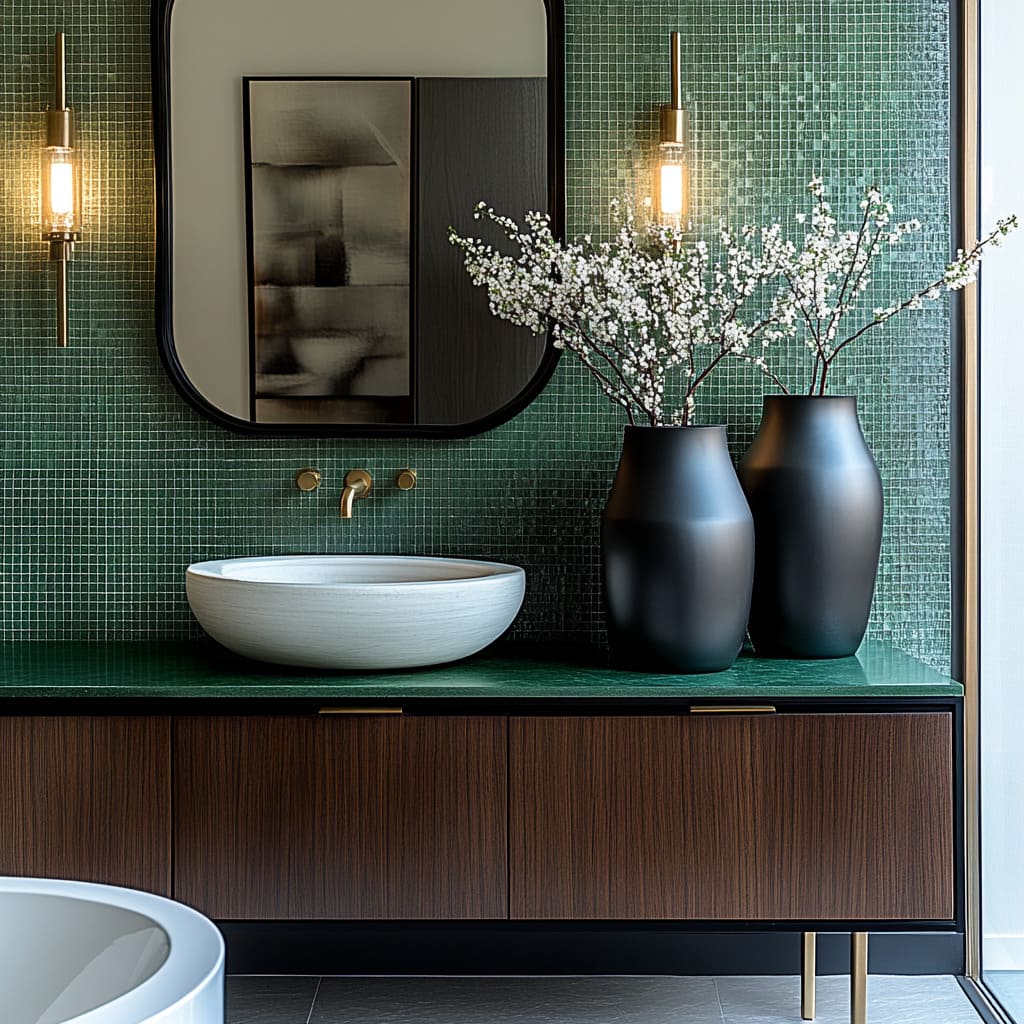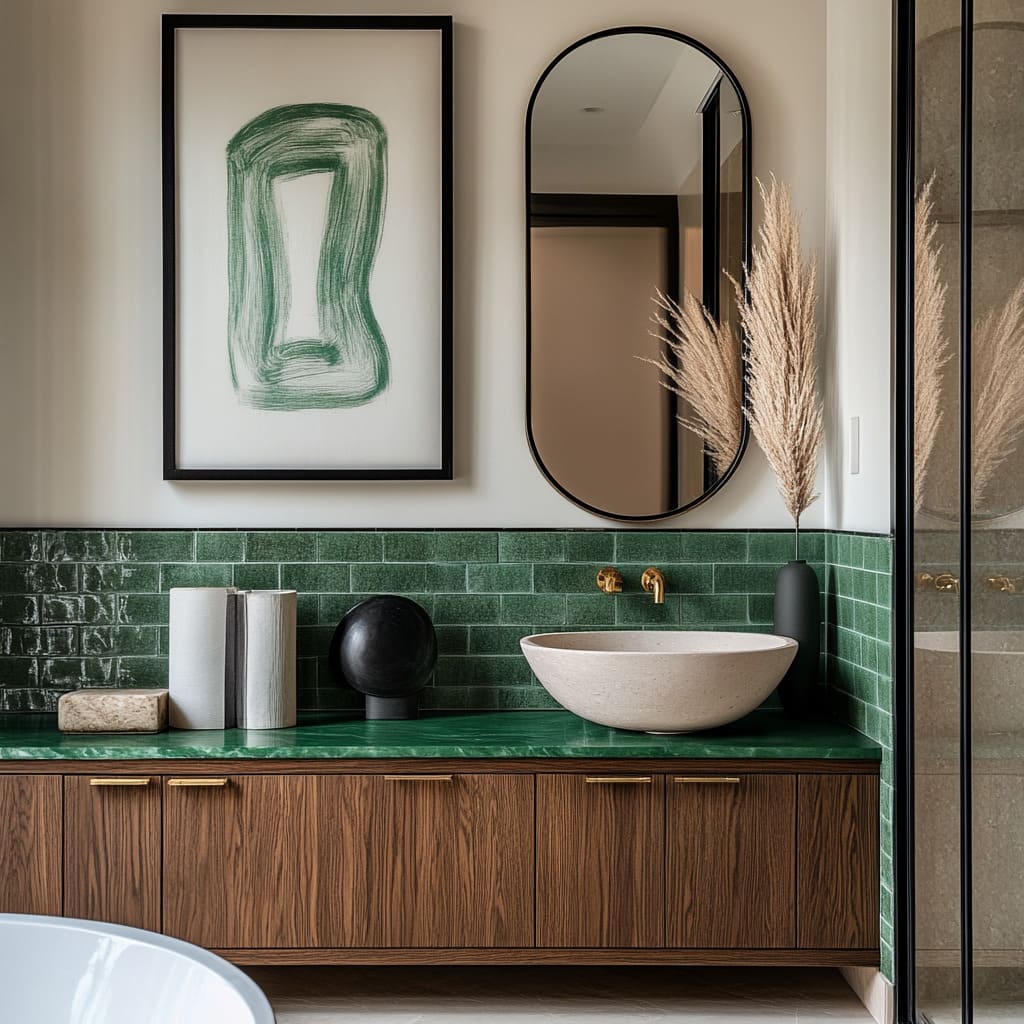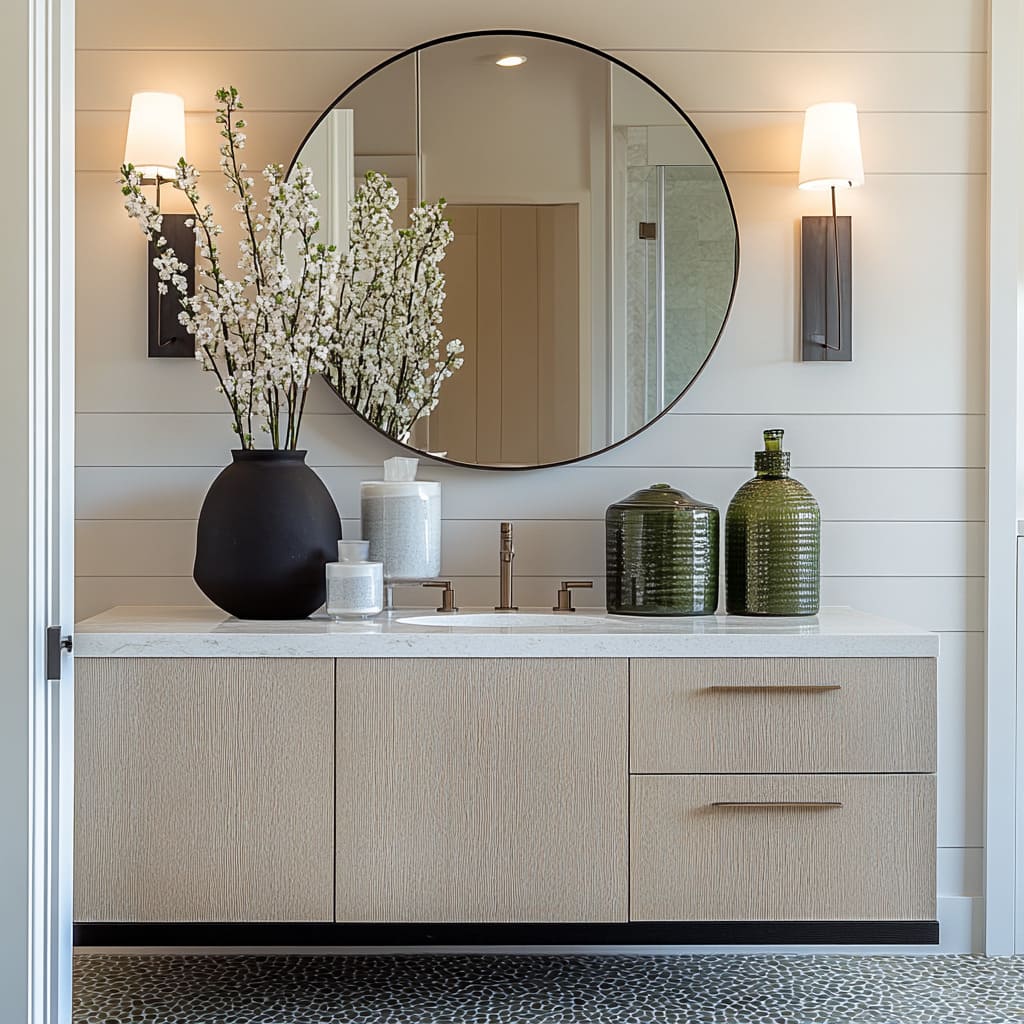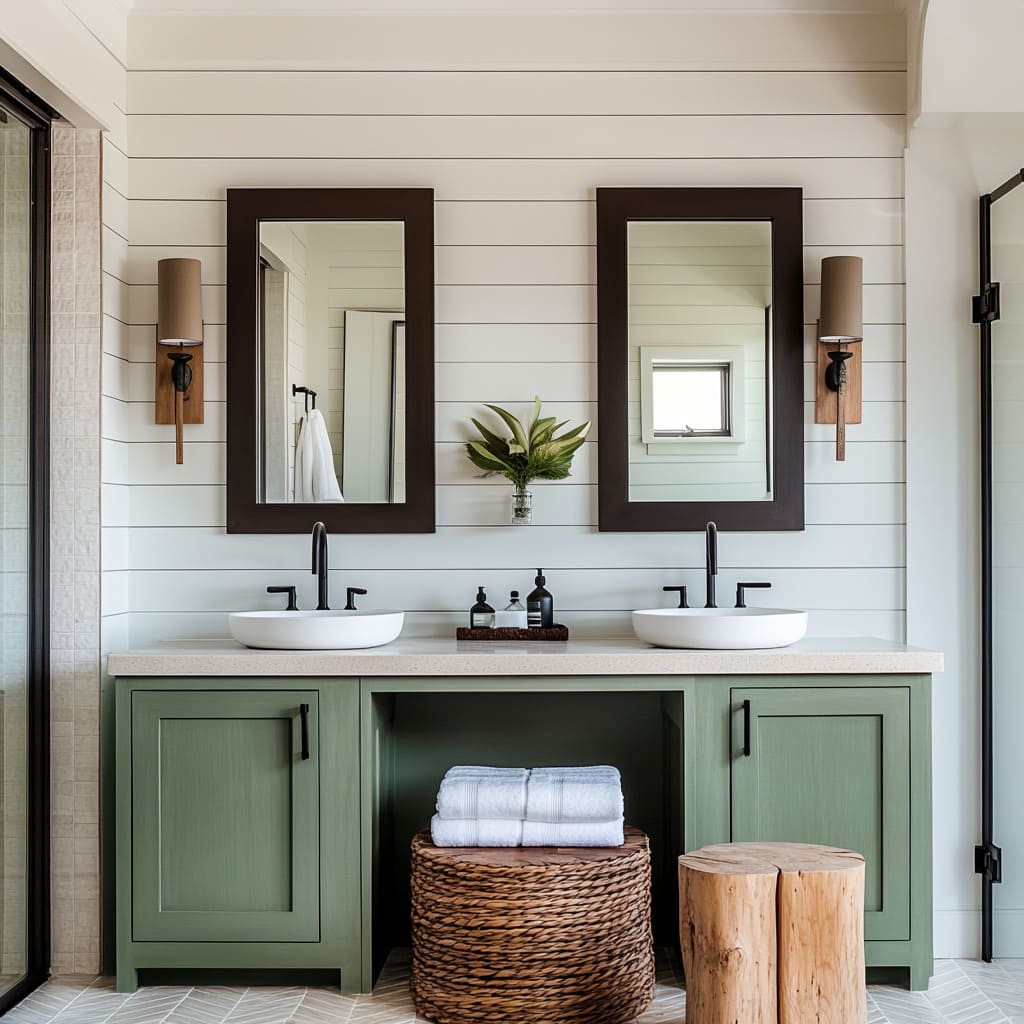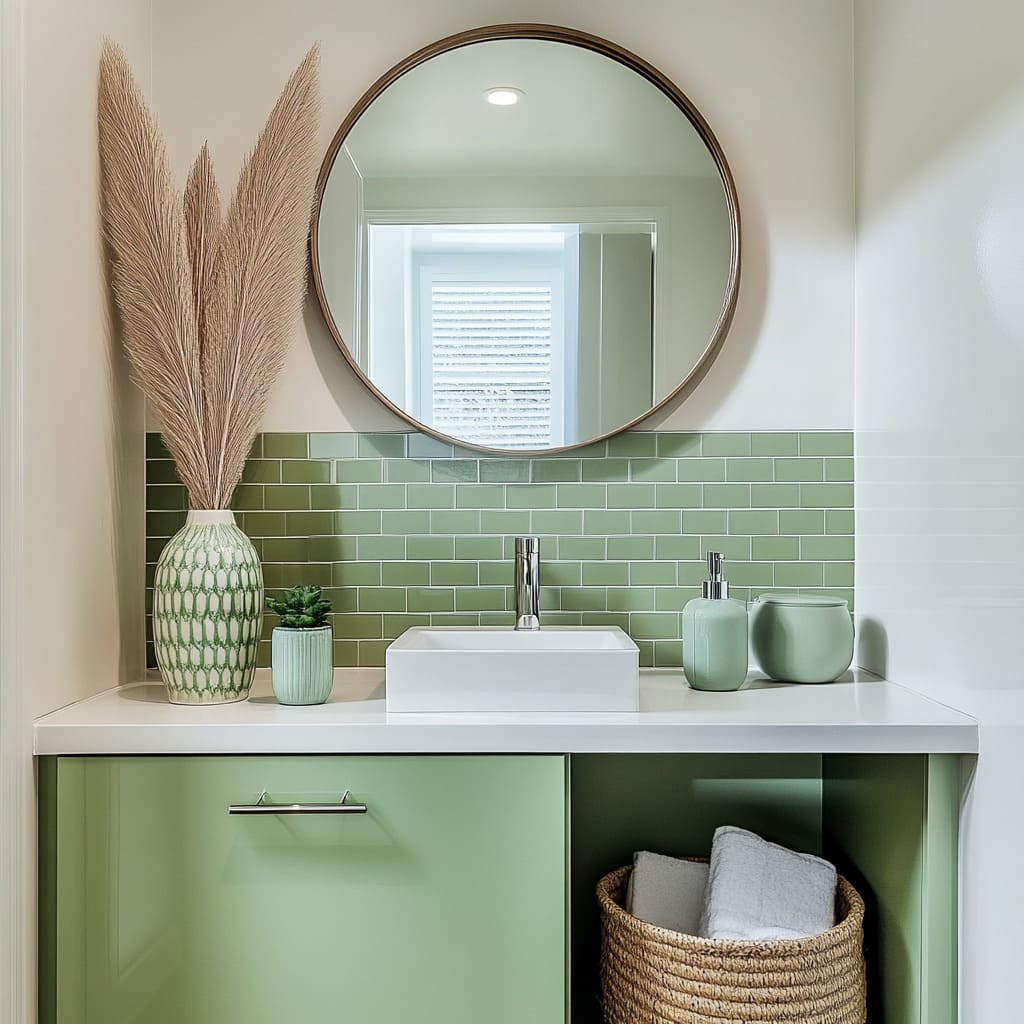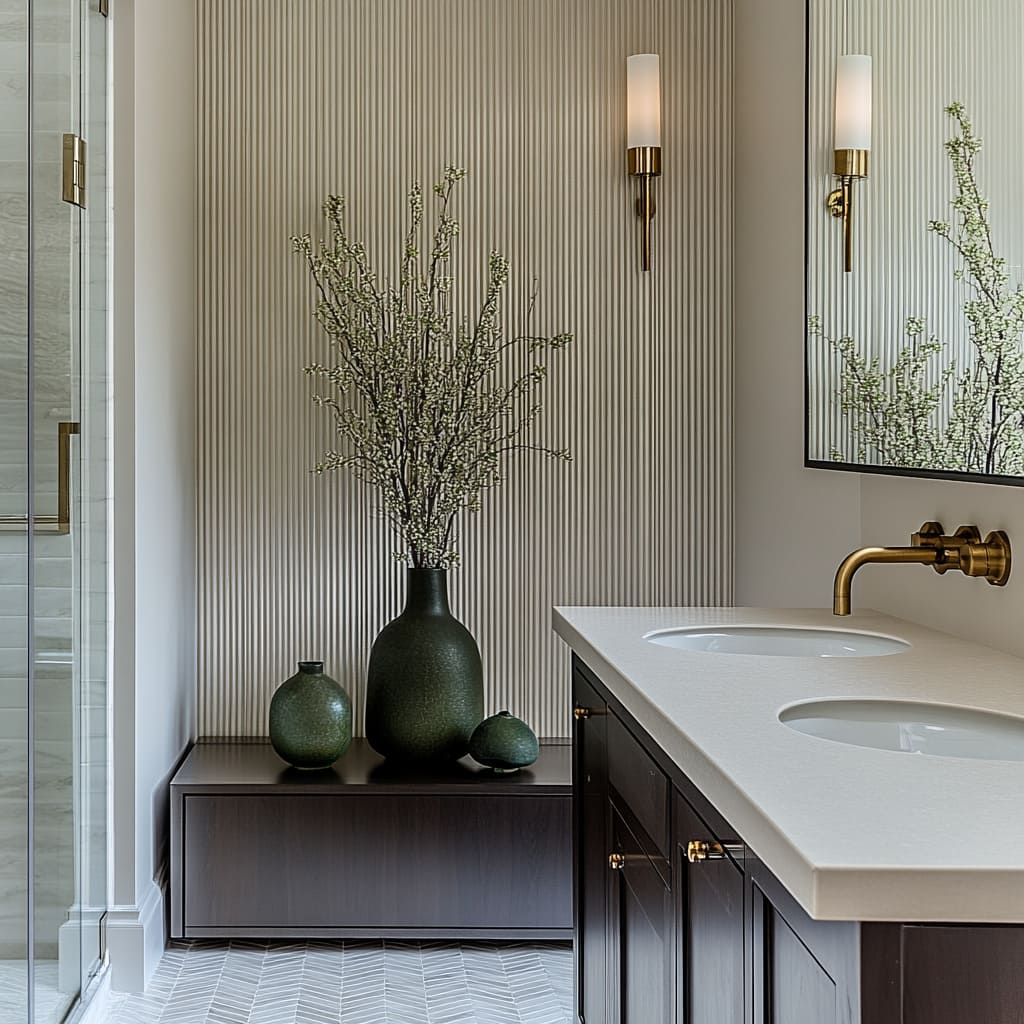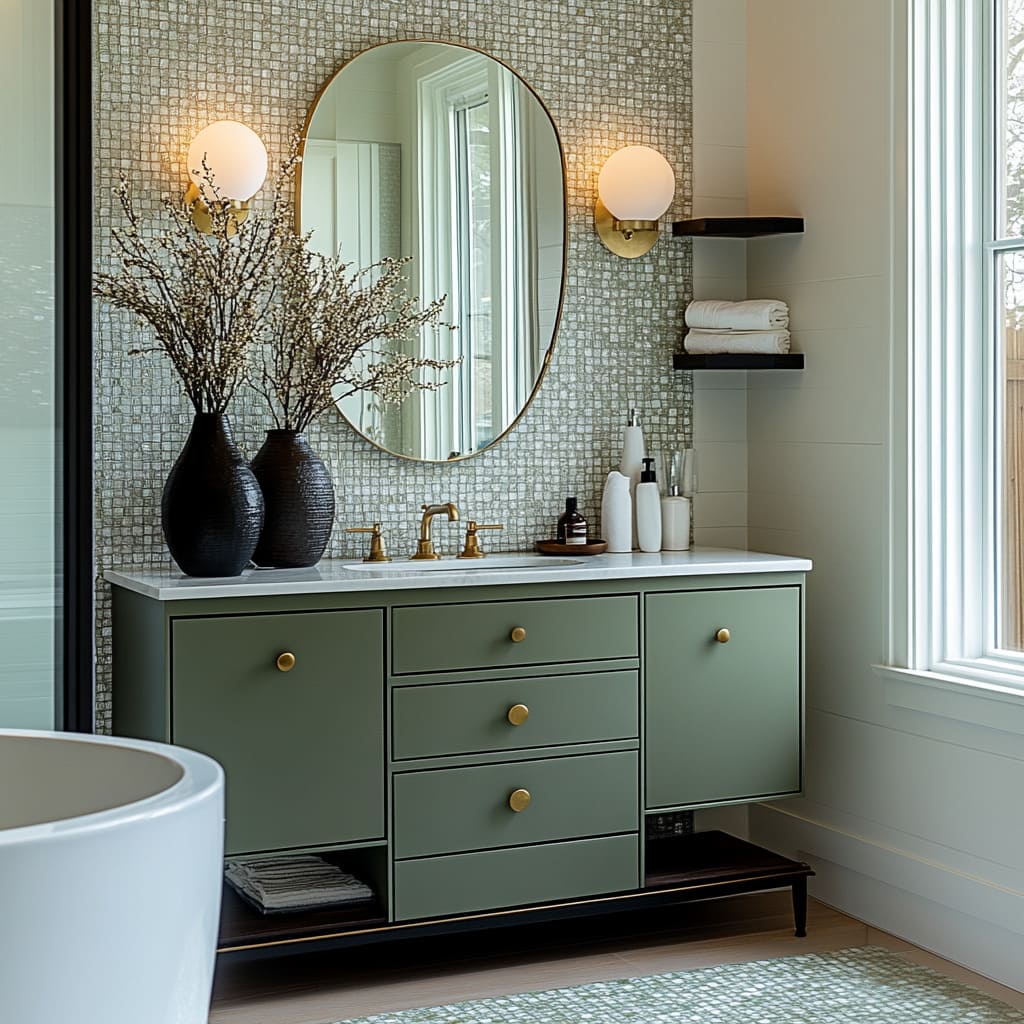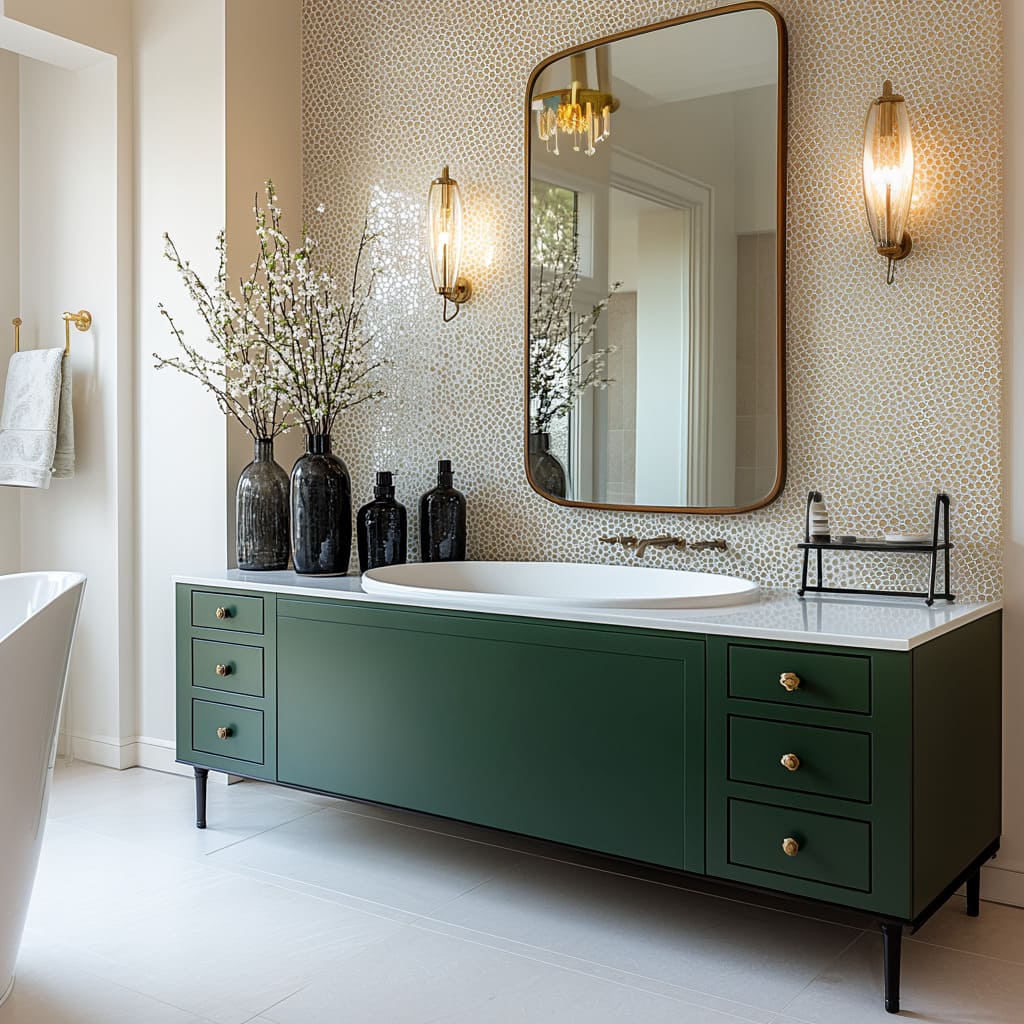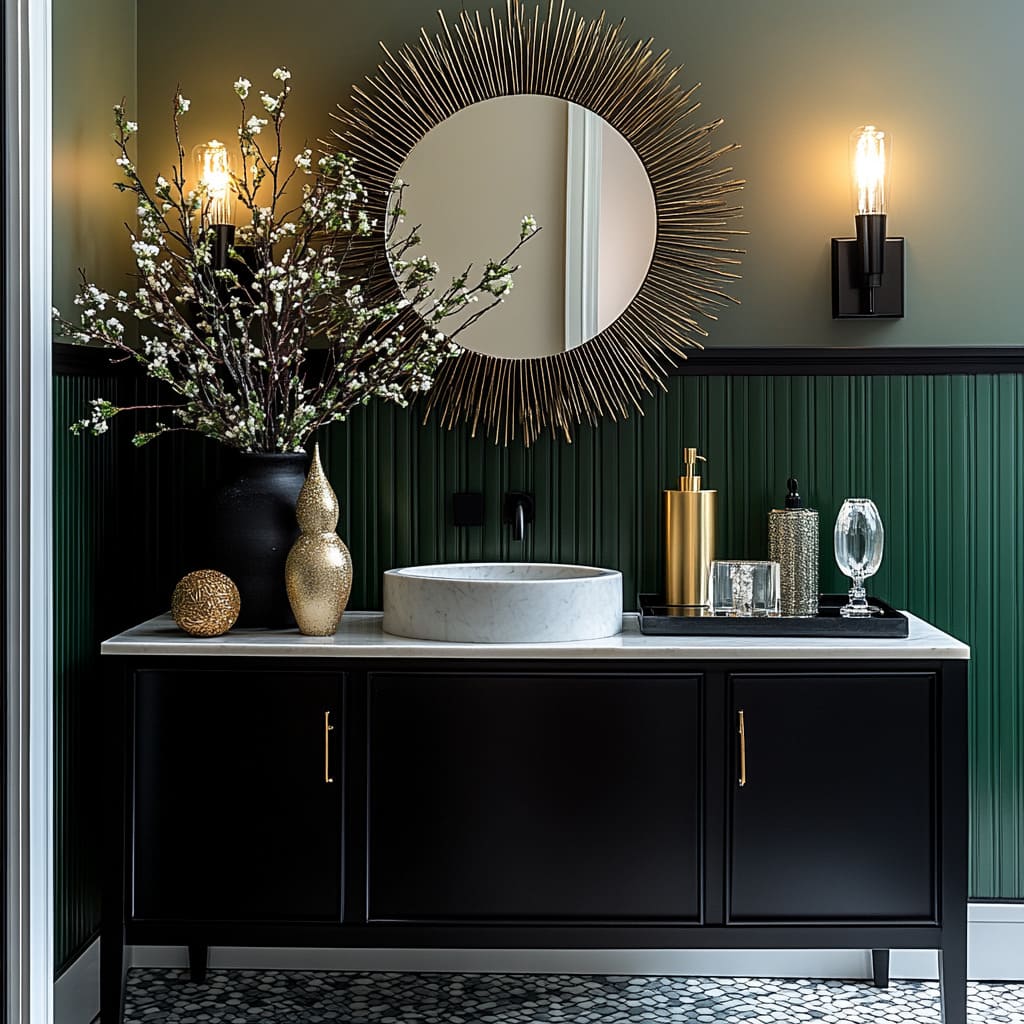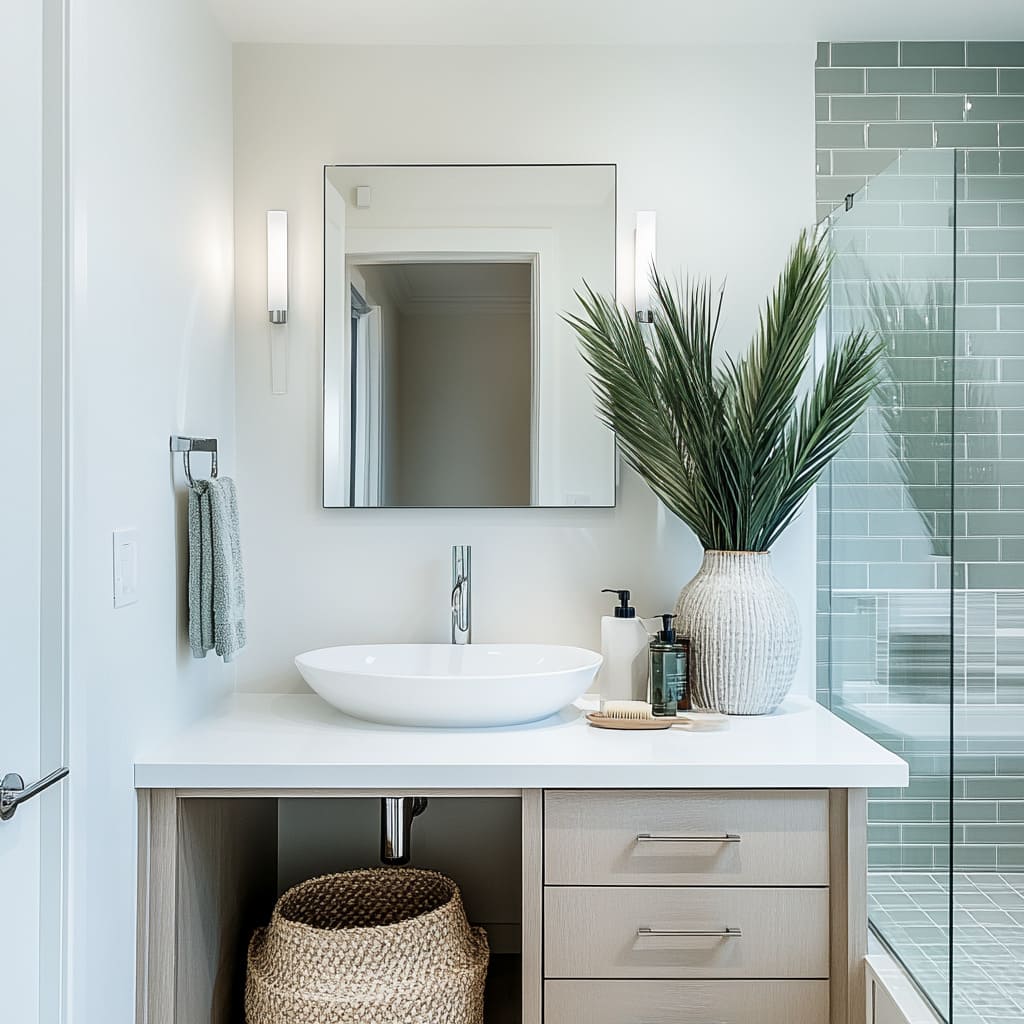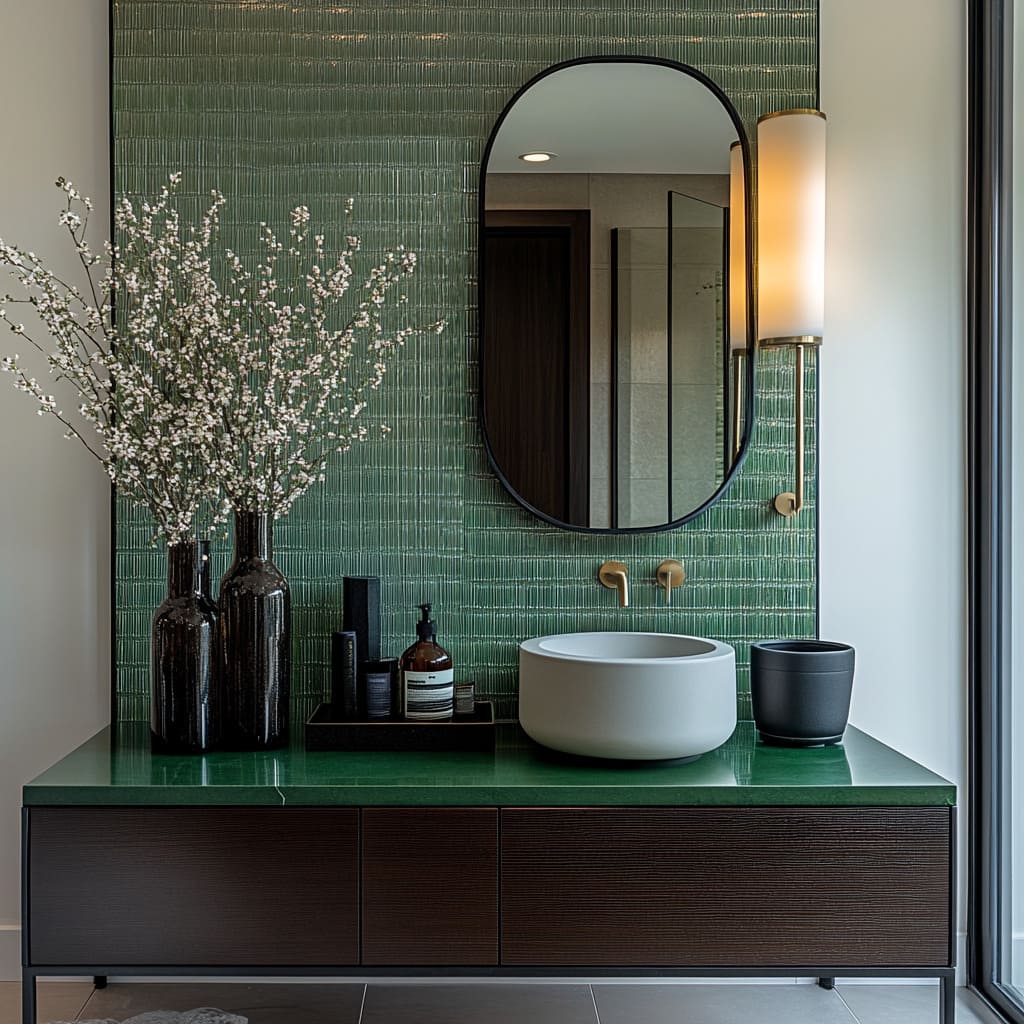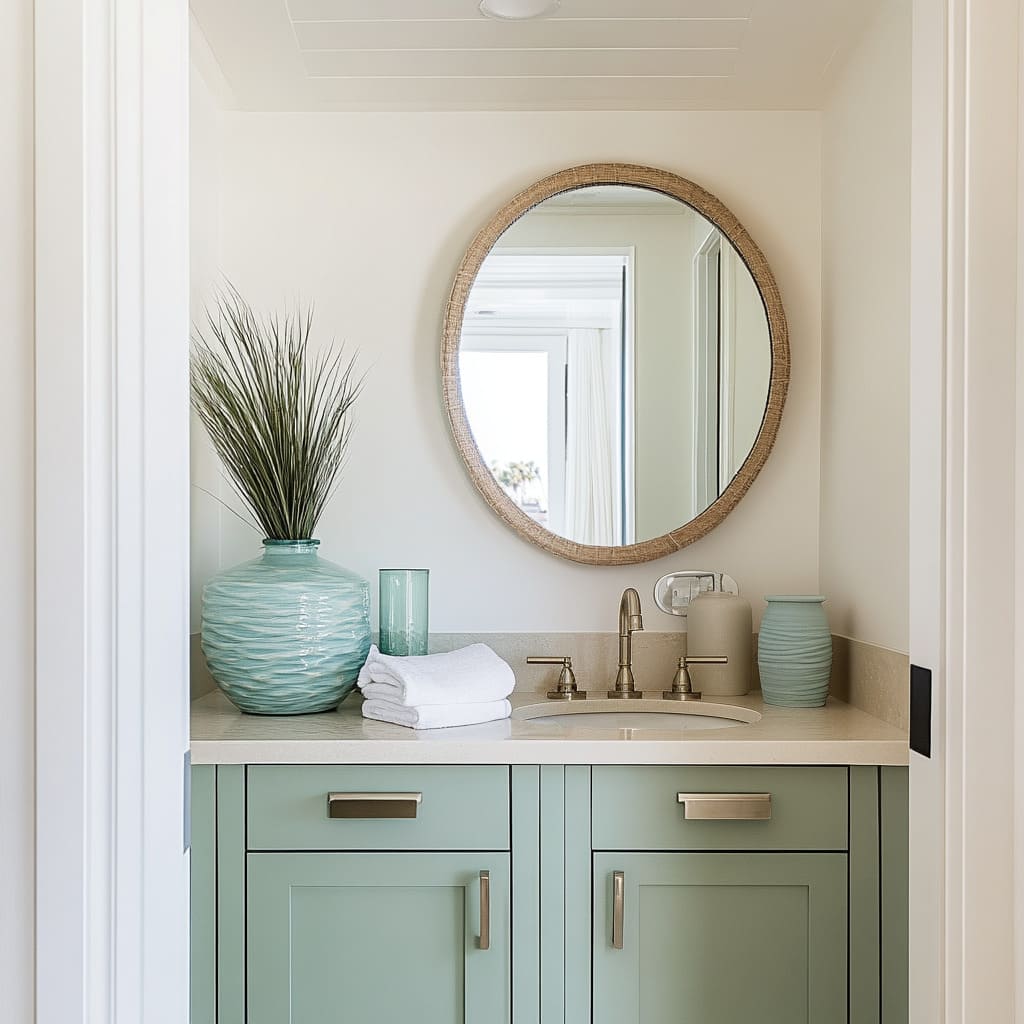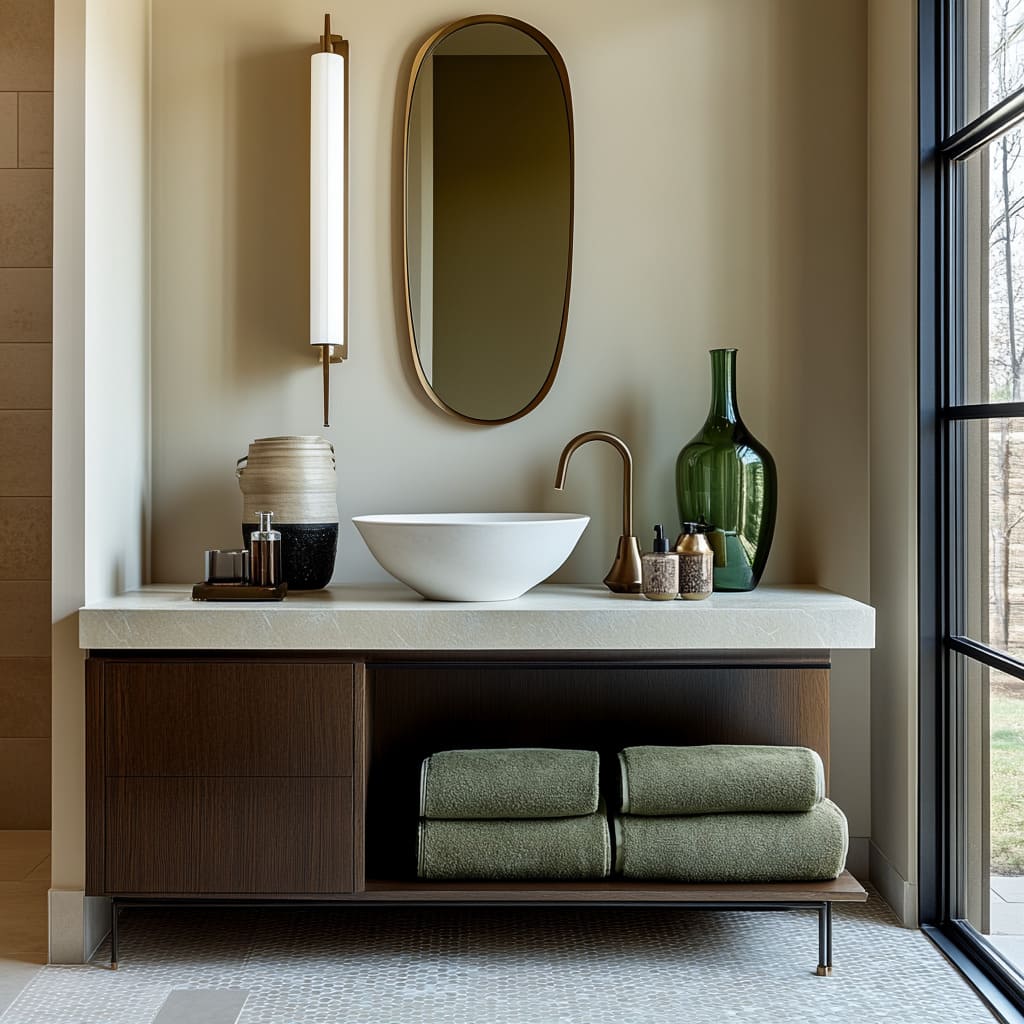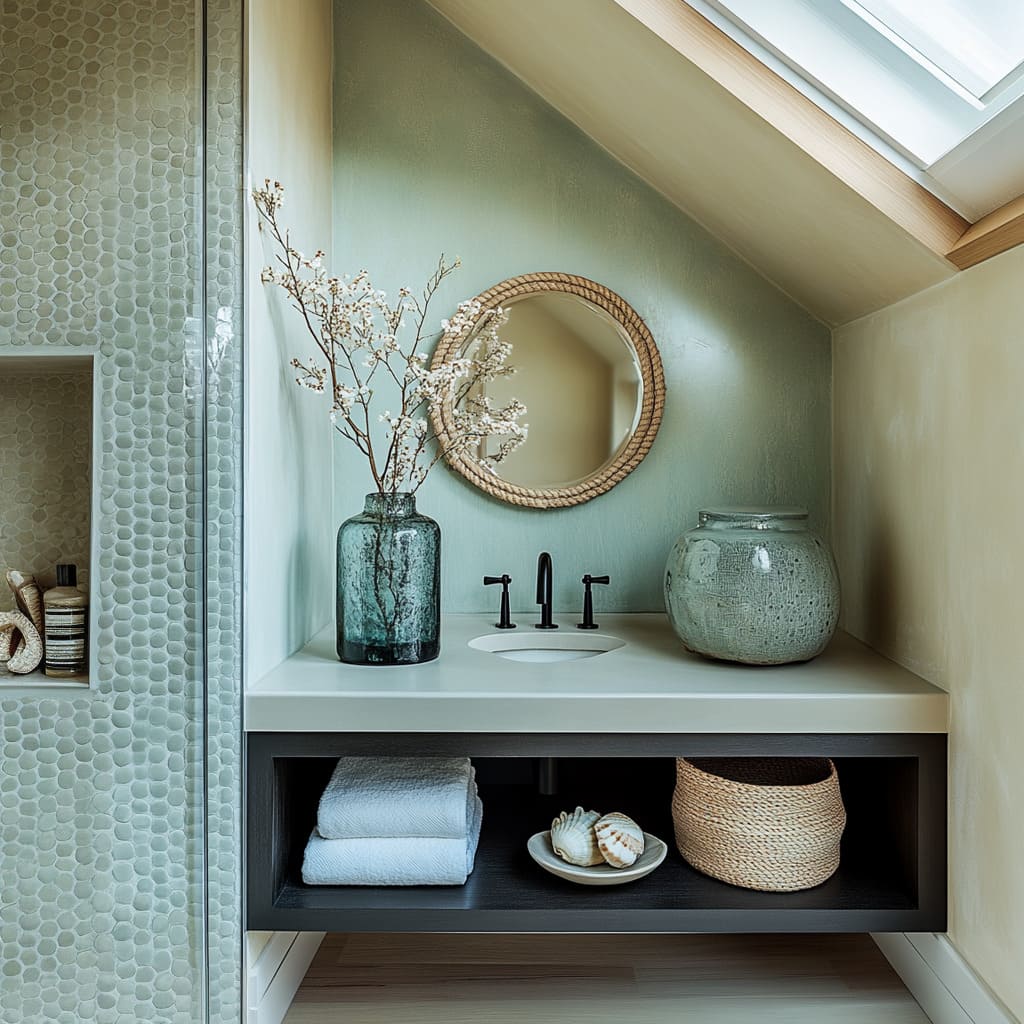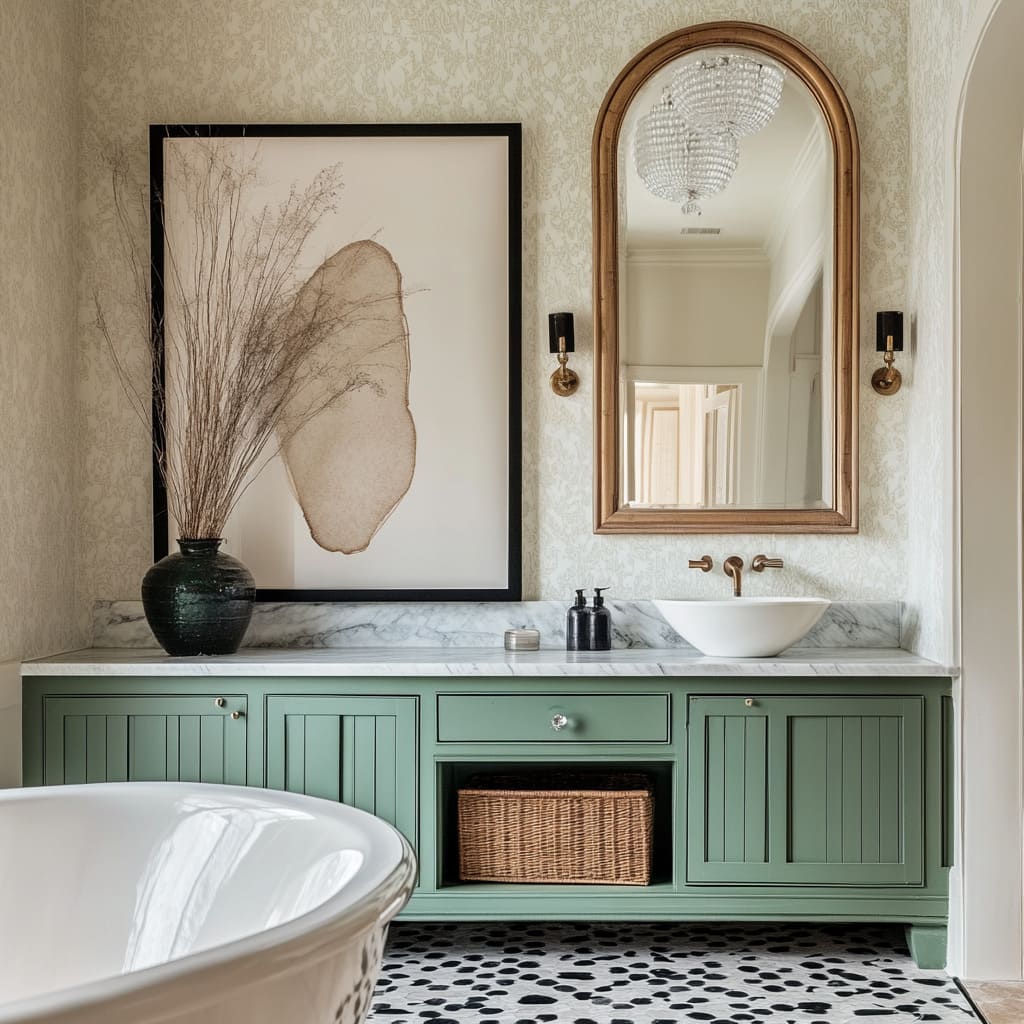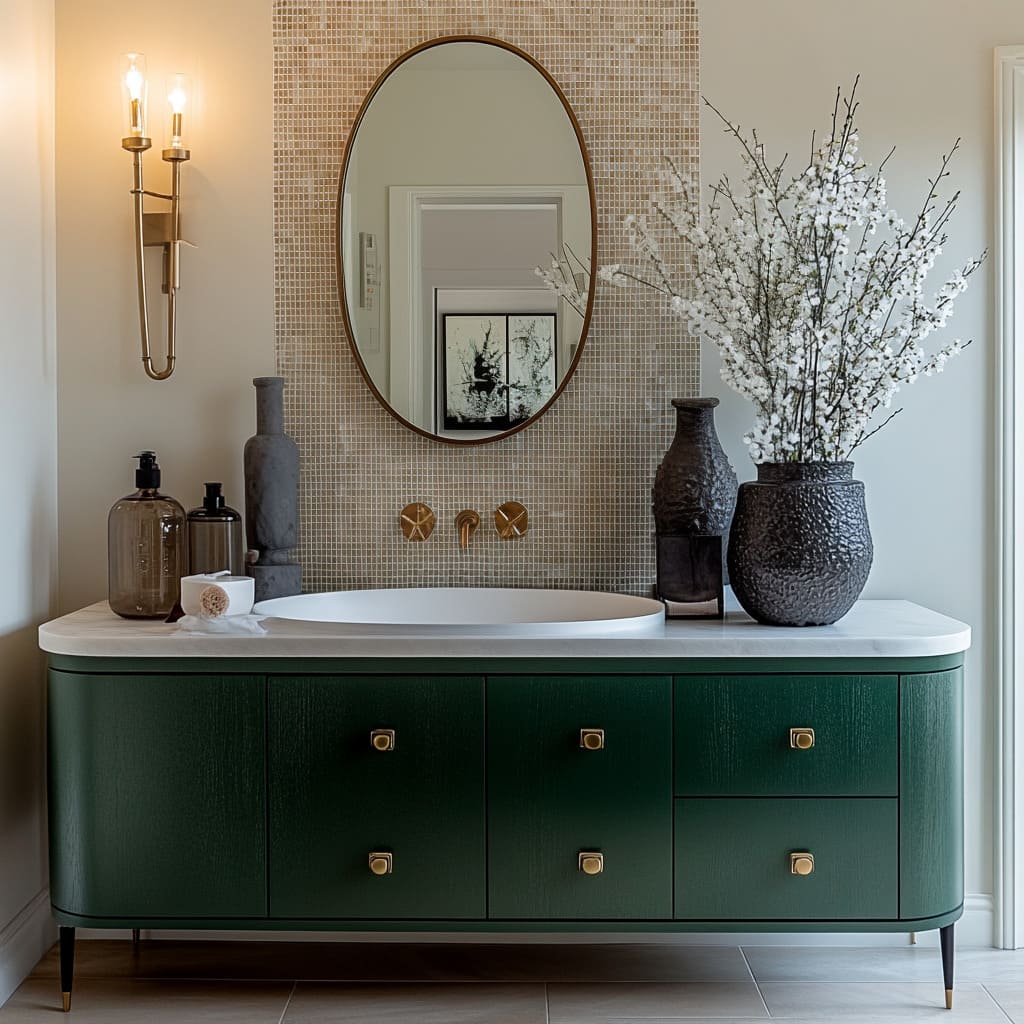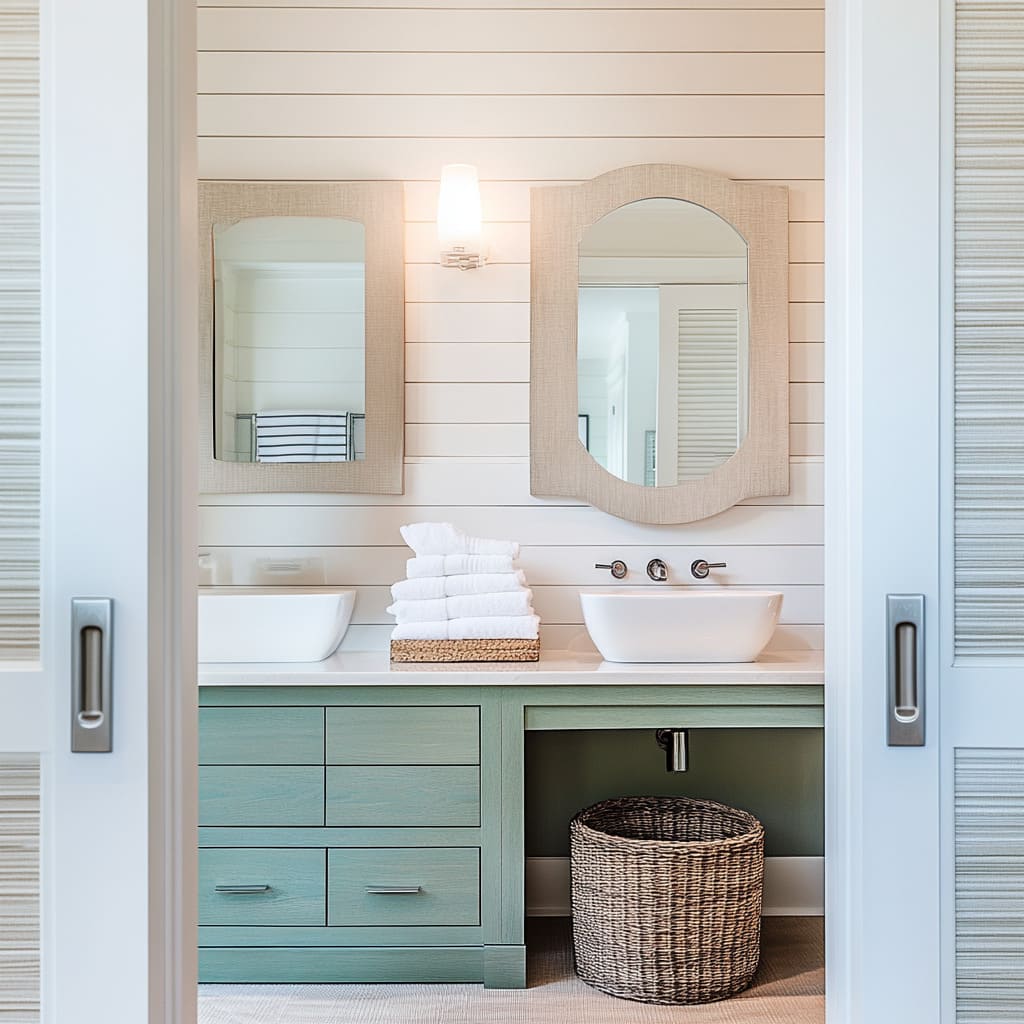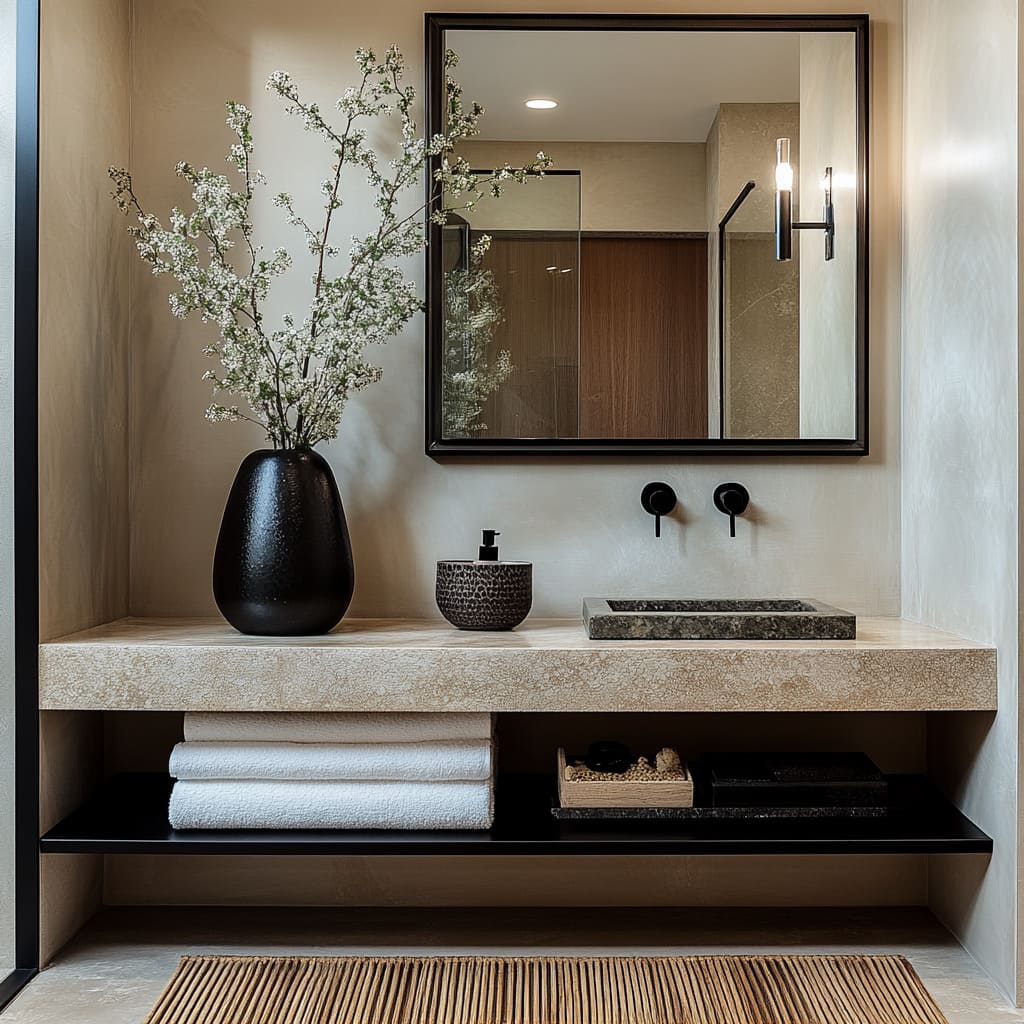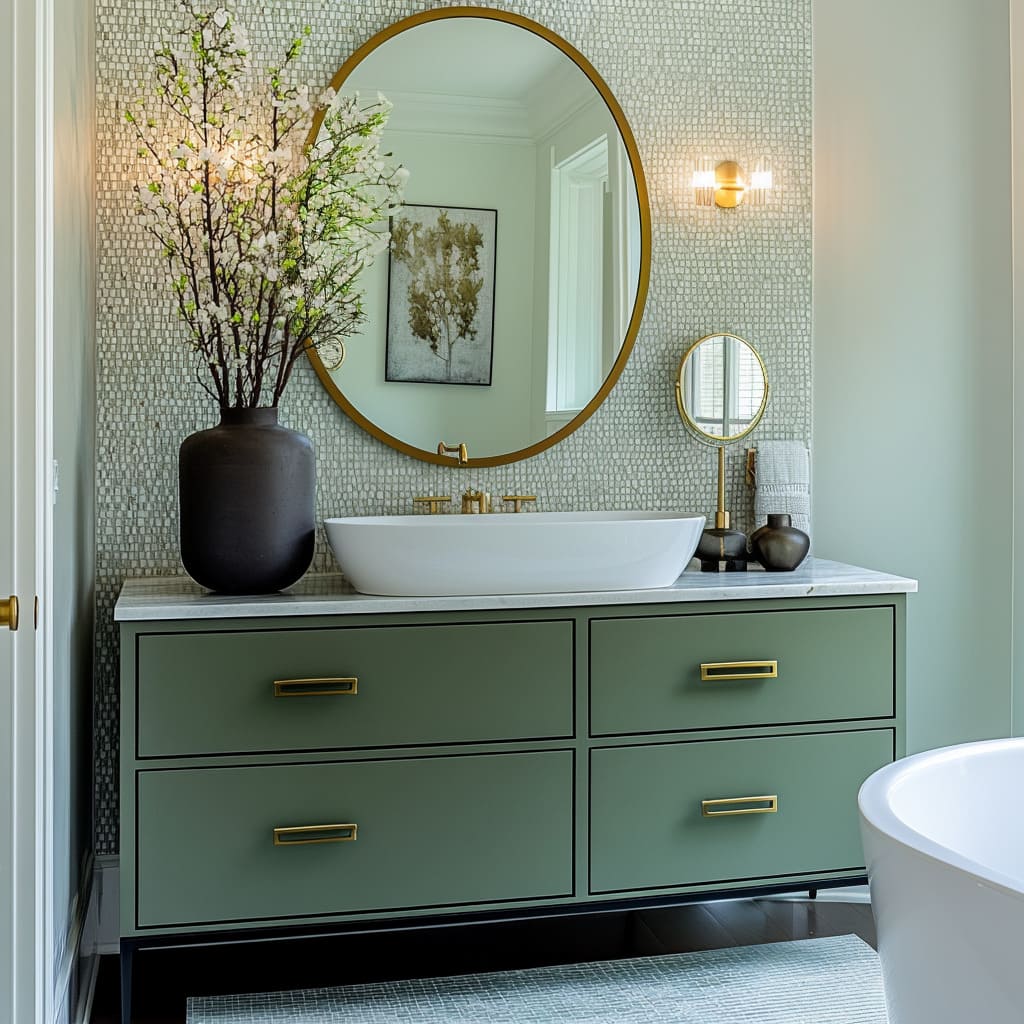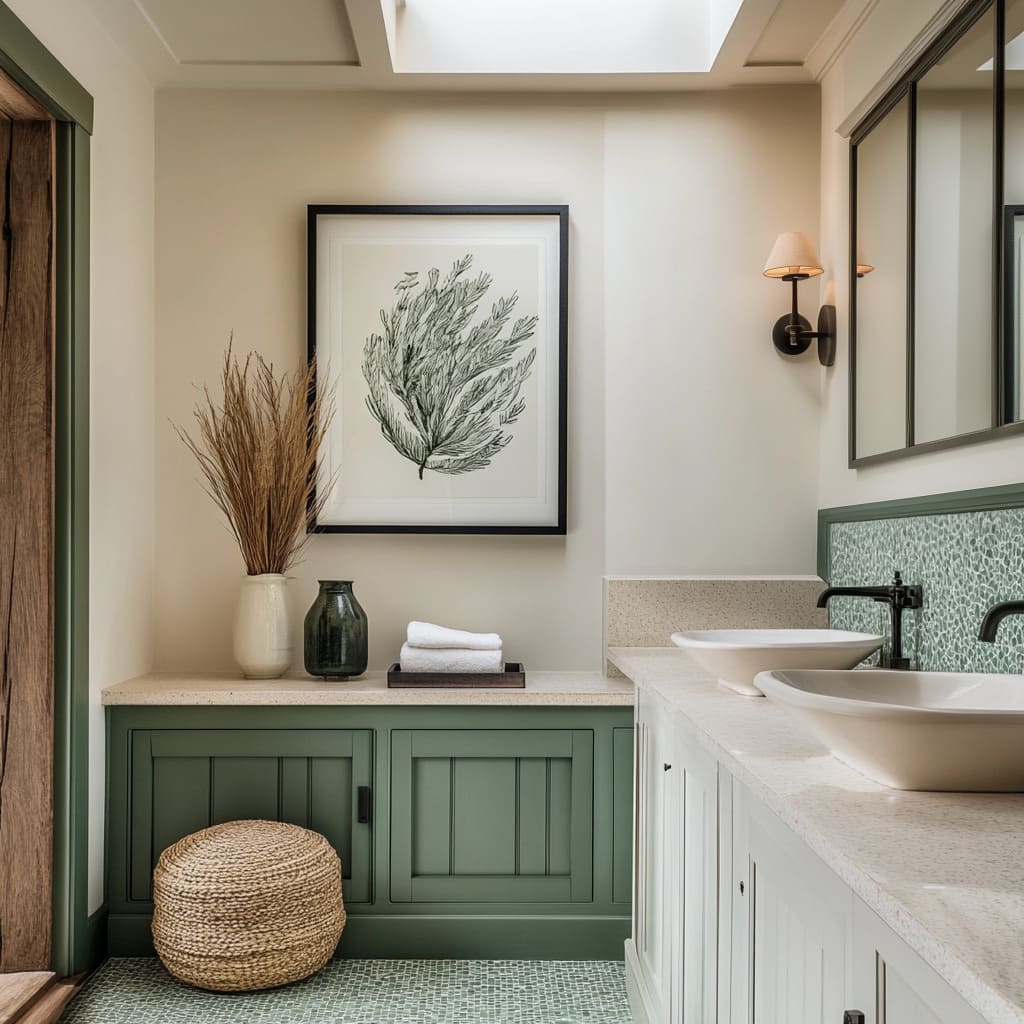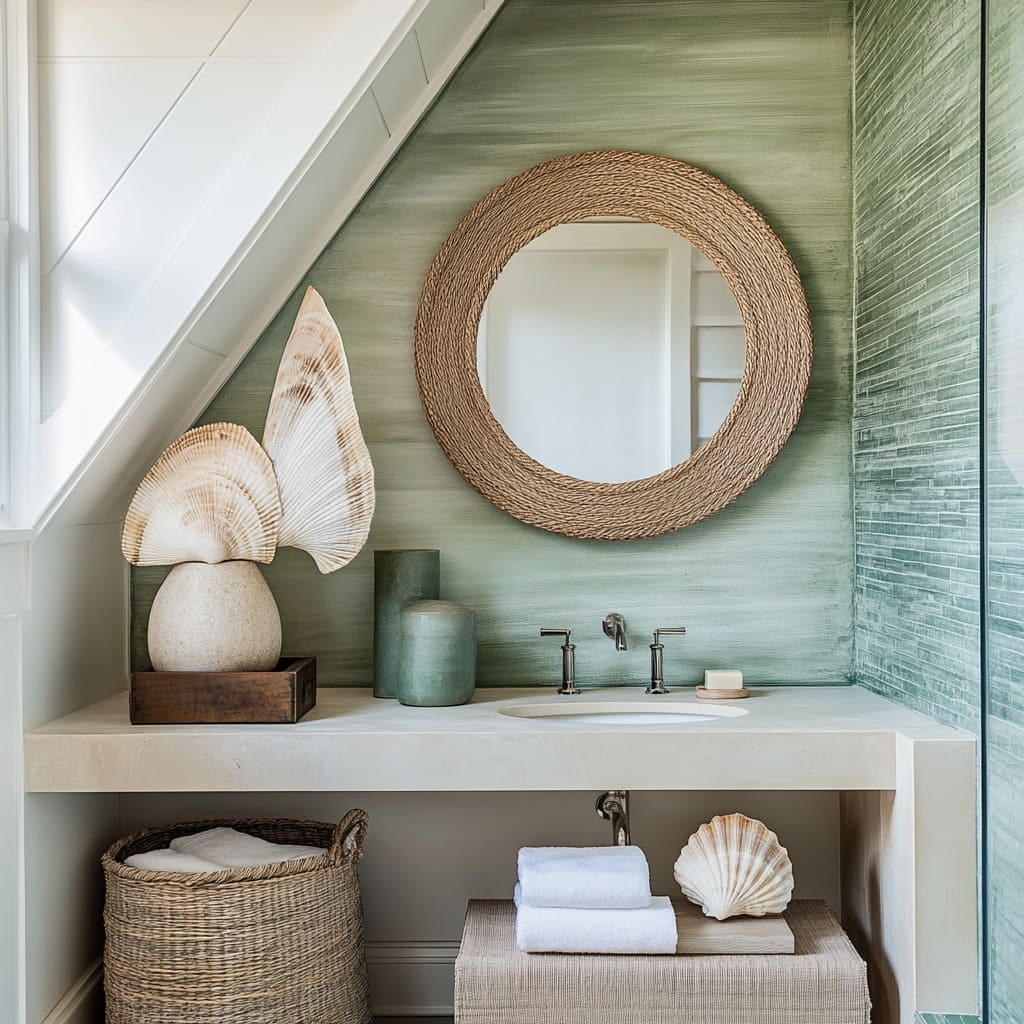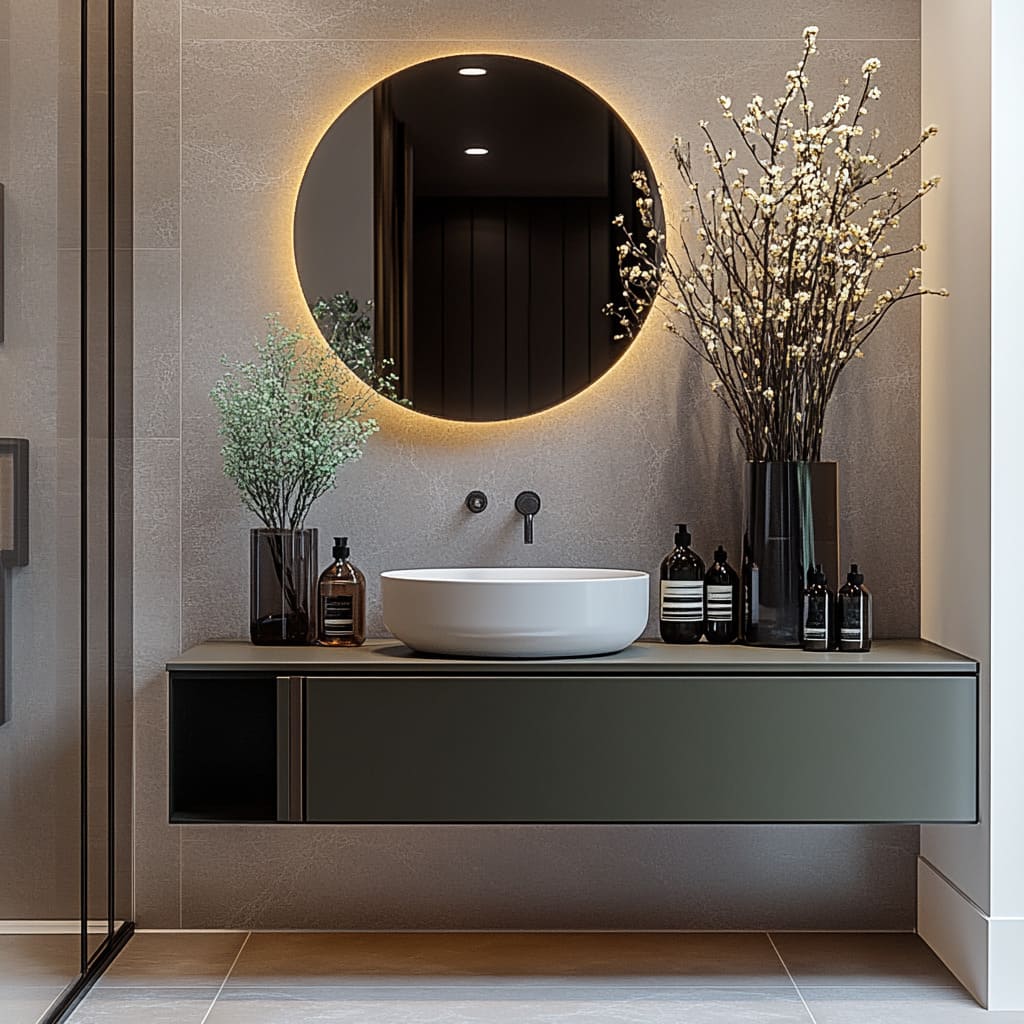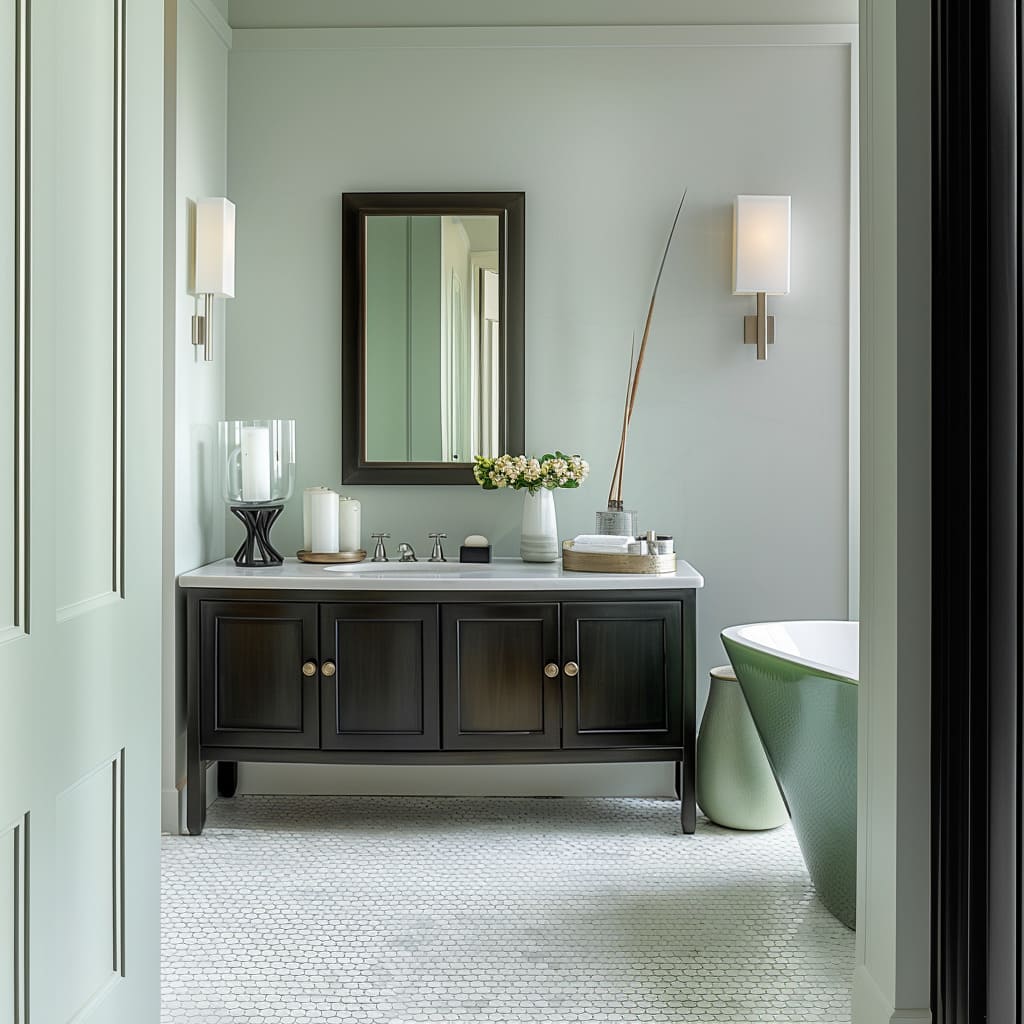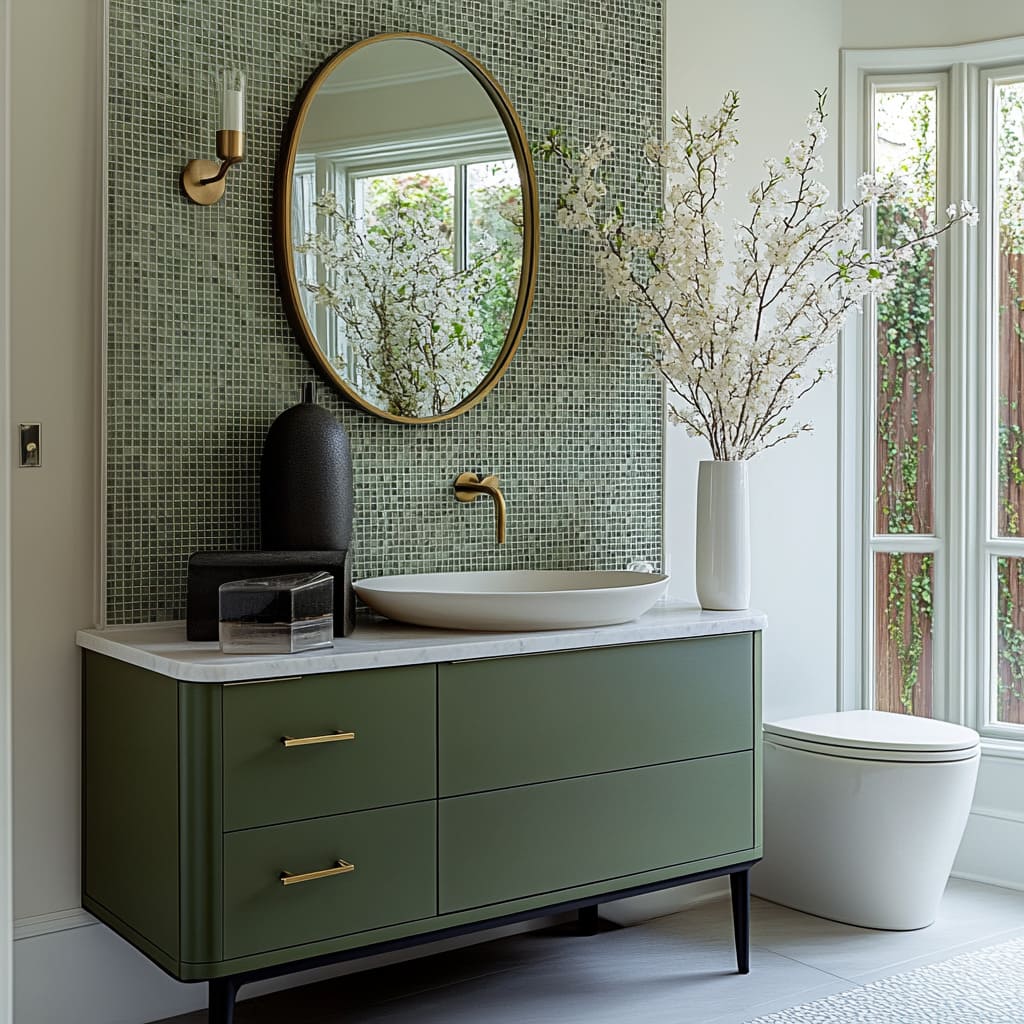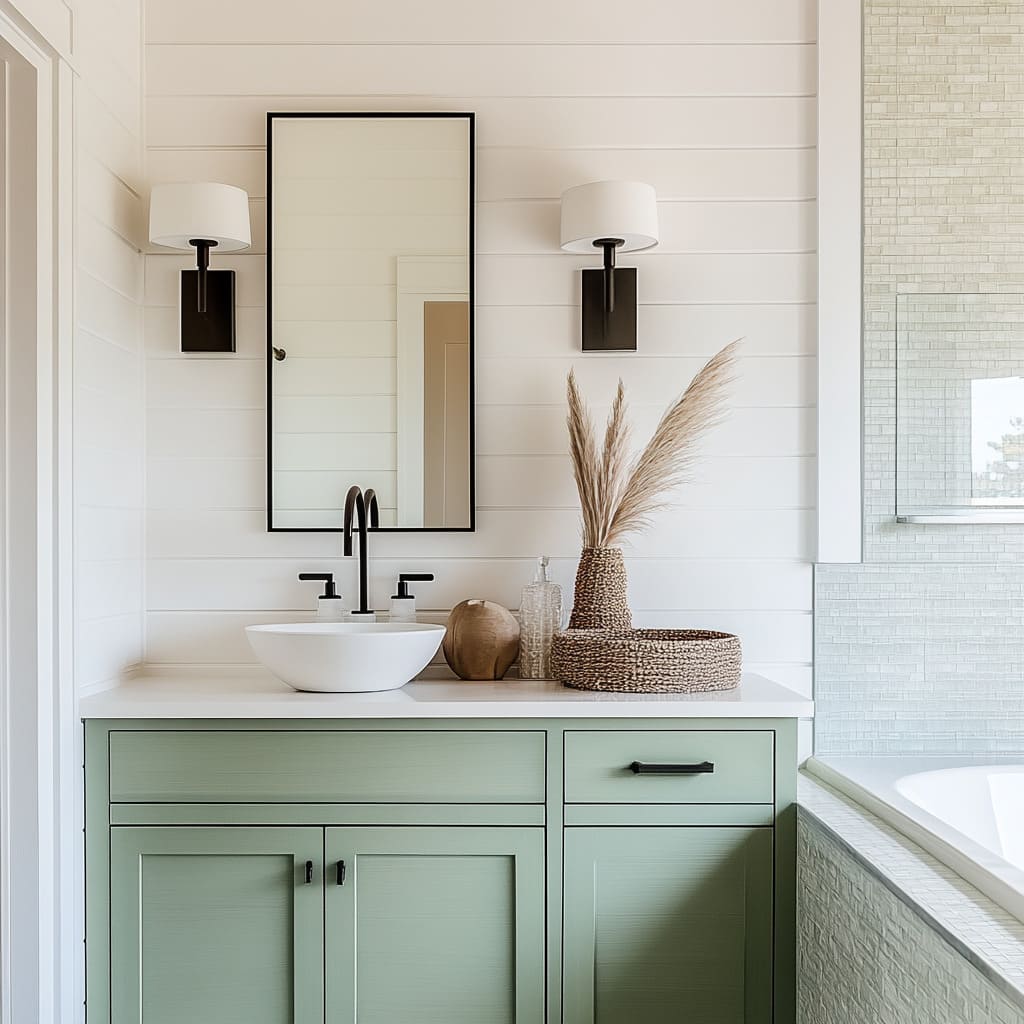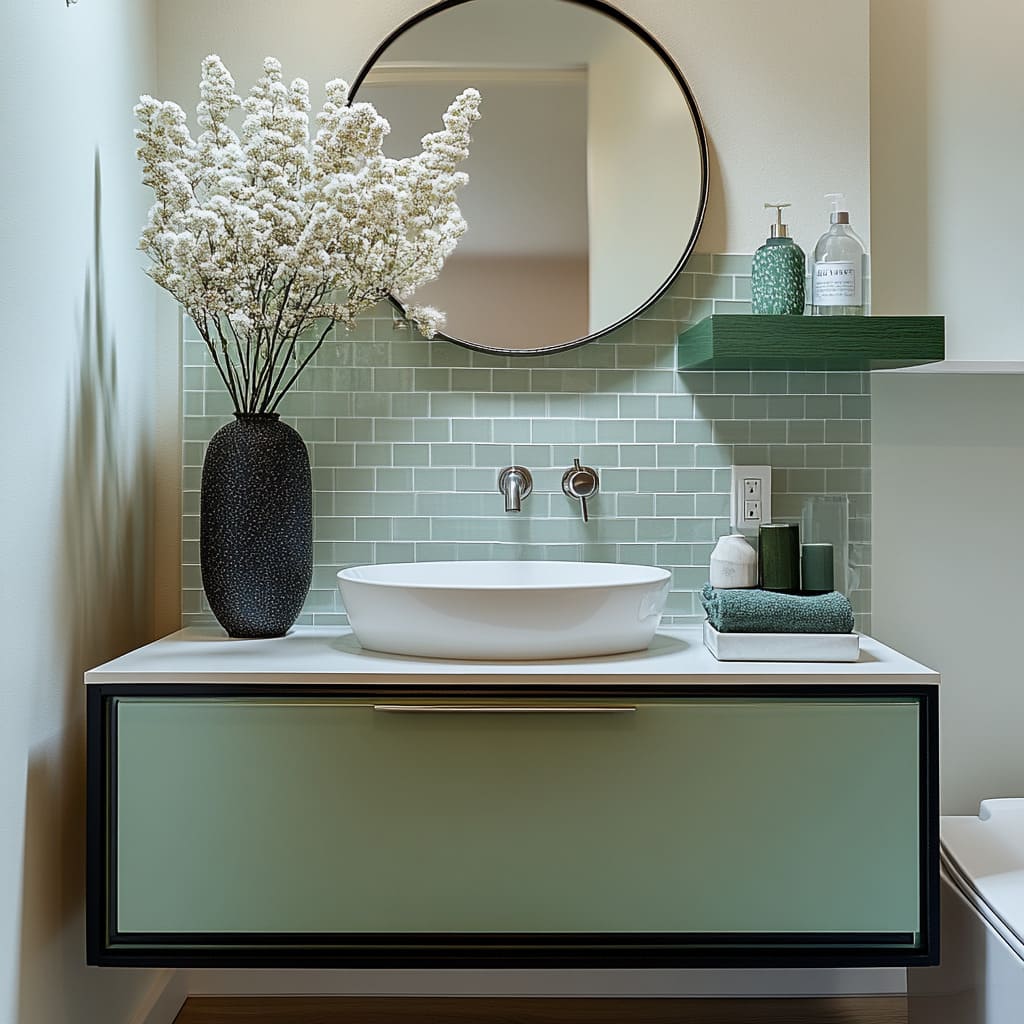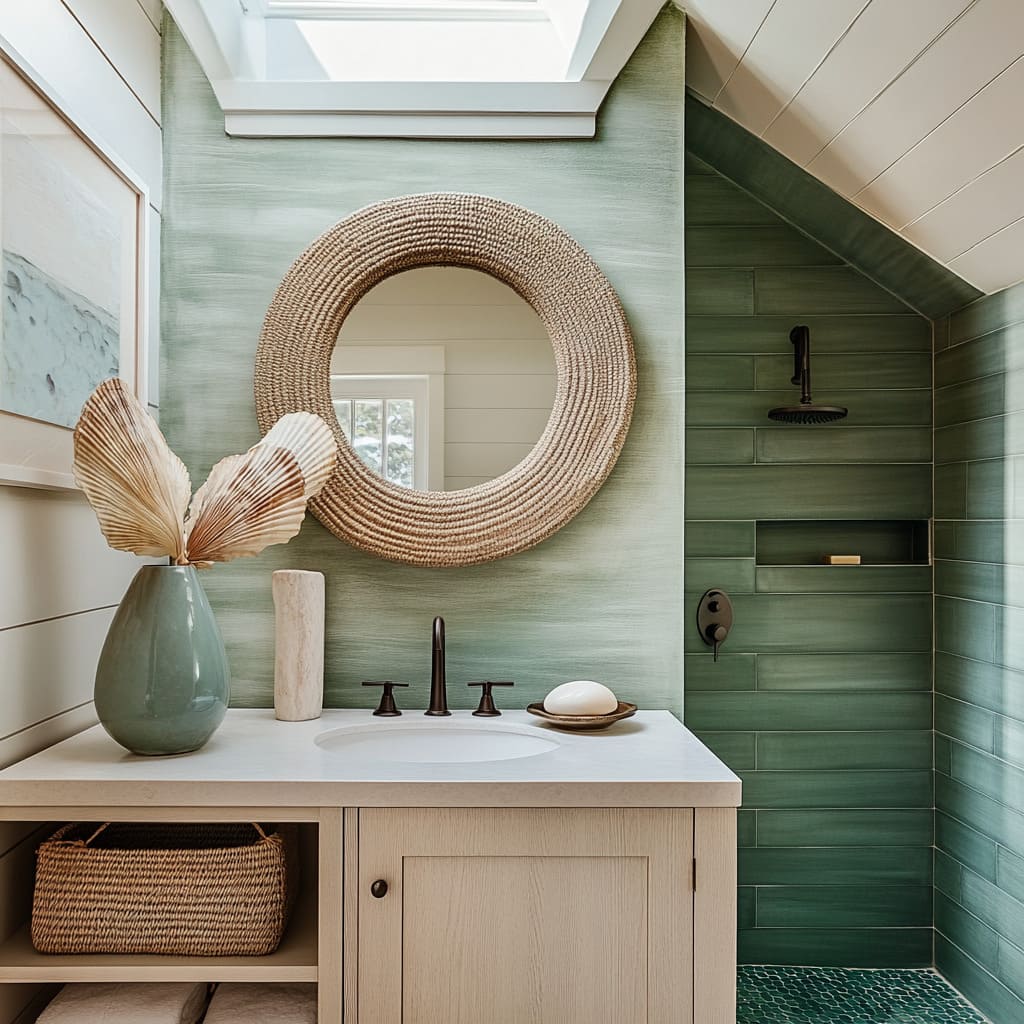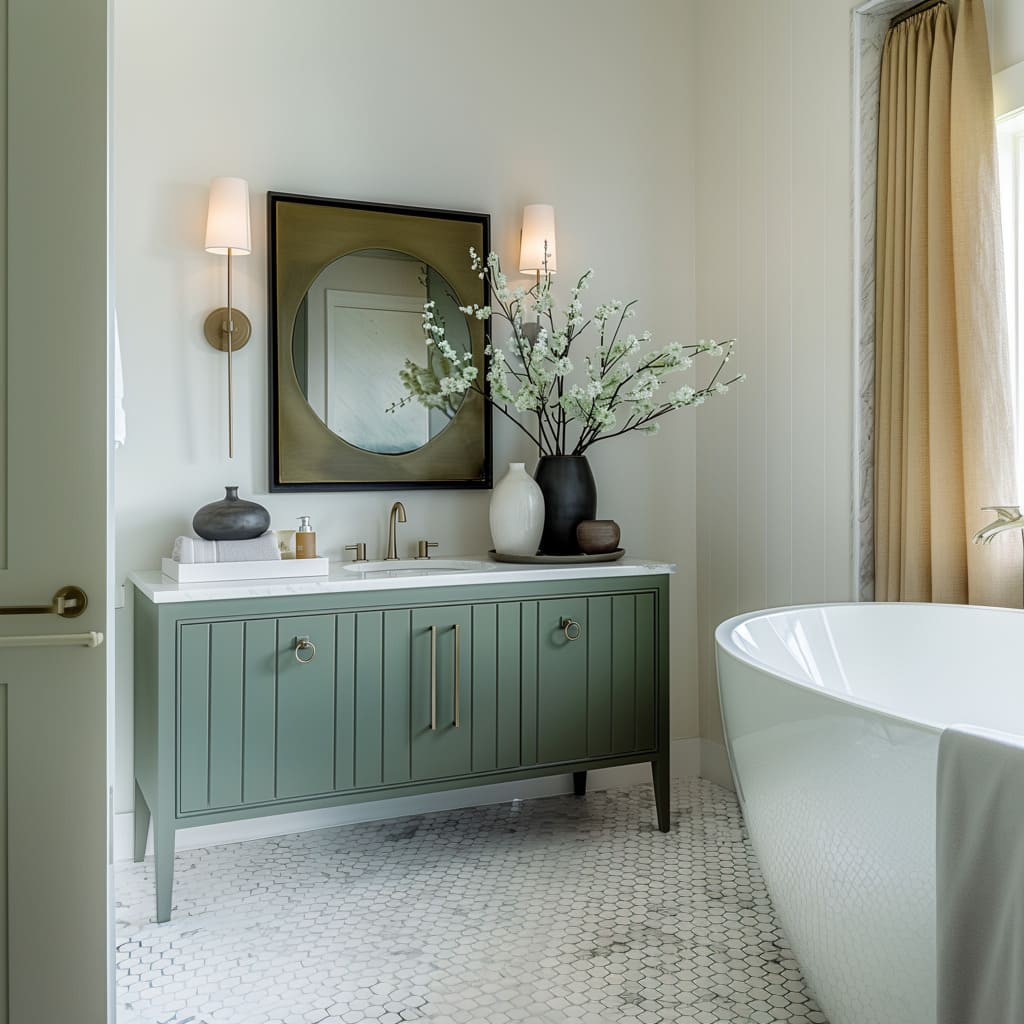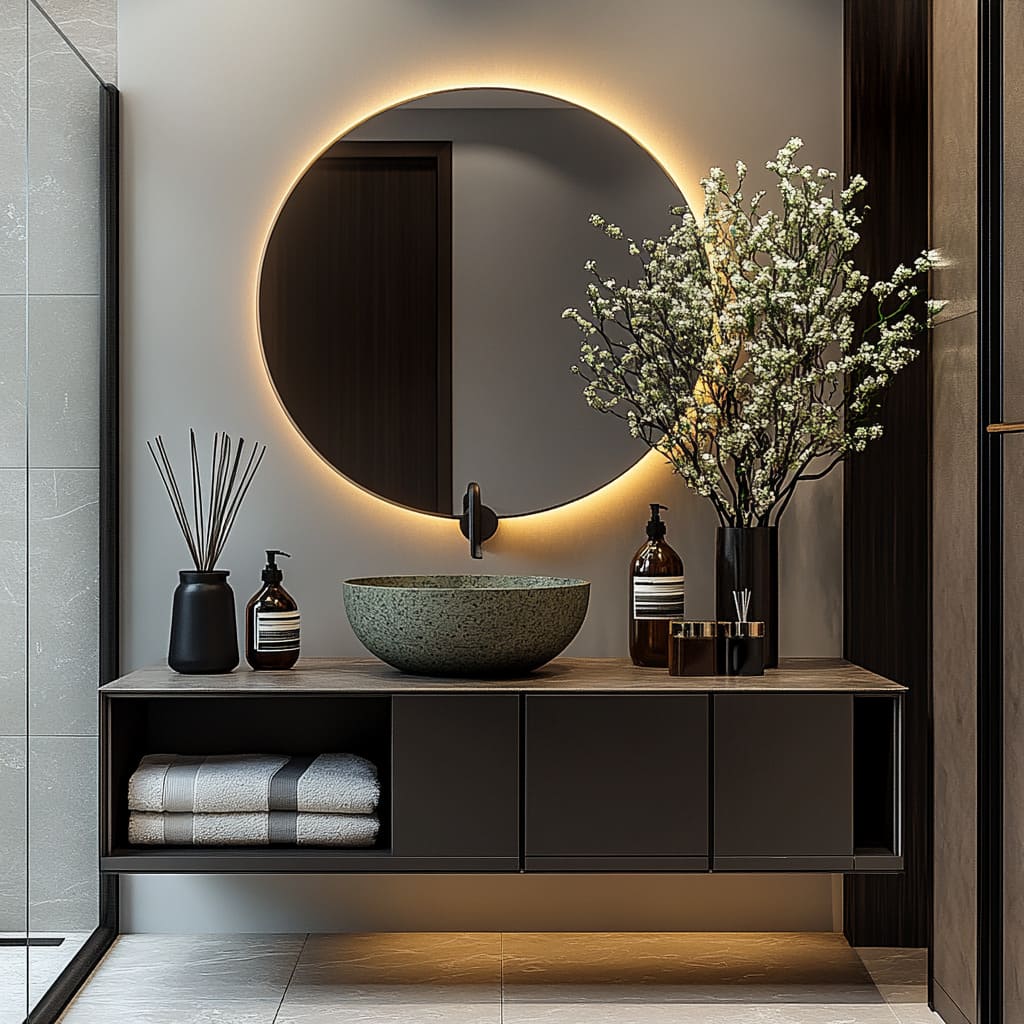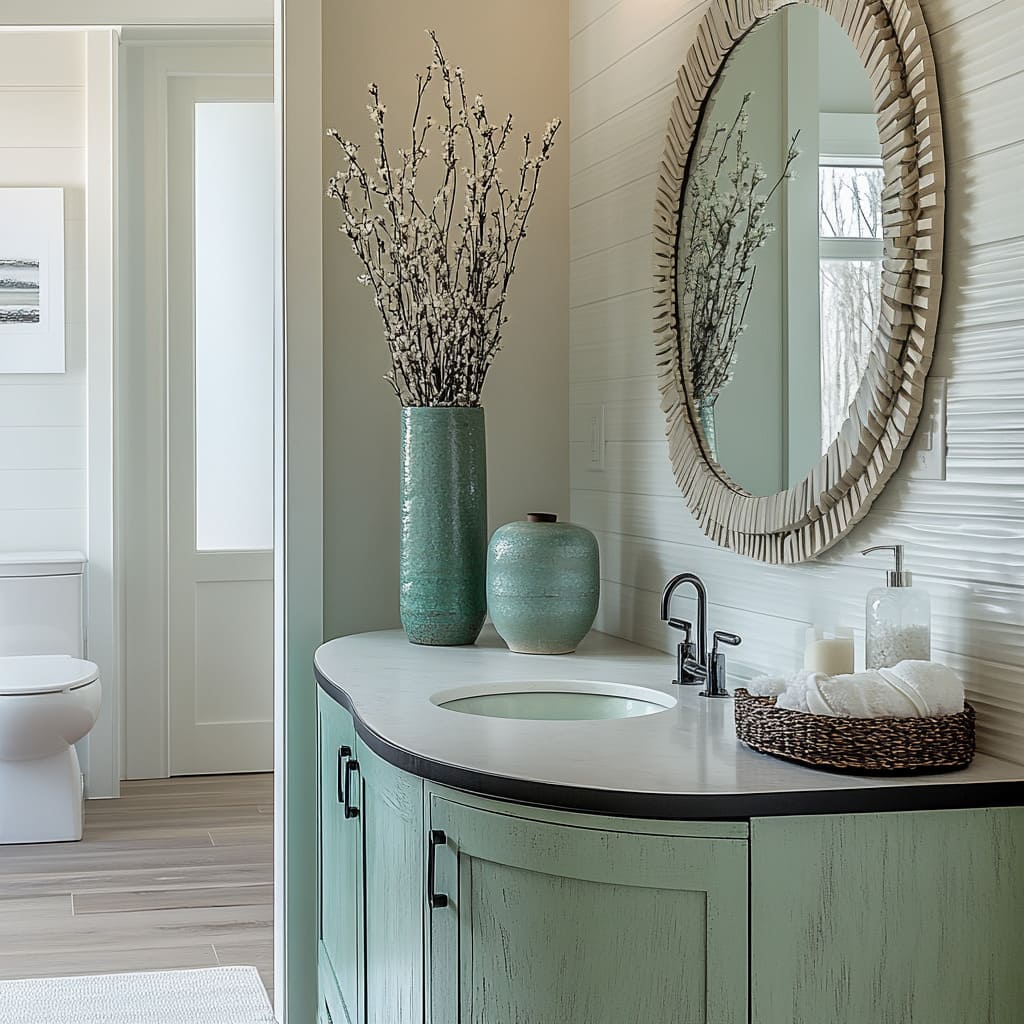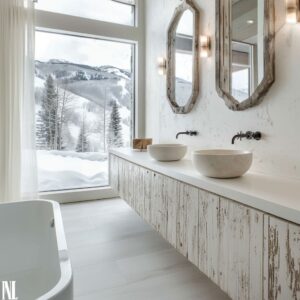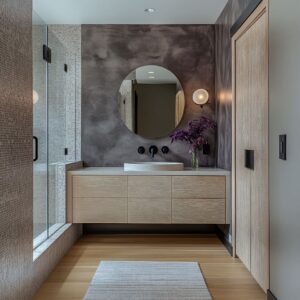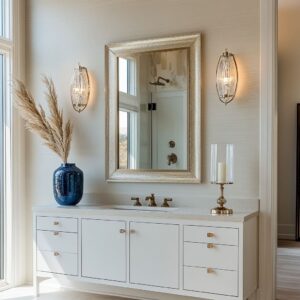Green bathrooms bring a sense of natural calm and revitalization to a space, offering a refreshing alternative to traditional color schemes. Rooted in nature-inspired aesthetics, this design approach has become a popular choice for homeowners seeking both style and functionality.
By thoughtfully incorporating green tones into your bathroom, you can create a space that feels inviting, balanced, and visually engaging.
This guide dives into practical ideas to design green bathrooms that stand out, combining aesthetics and usability. Whether you’re revamping an urban apartment or designing a countryside retreat, green can act as a transformative anchor for your bathroom’s overall look and feel.
With the right elements, this color can help define the mood while enhancing the space’s features to create a harmonious environment. Green as a central theme offers flexibility; its wide spectrum—from soft sage to bold emerald—makes it adaptable to numerous styles, including modern minimalism, traditional charm, and contemporary sophistication.
This adaptability allows green to serve as either a primary focus or an accent, depending on your vision.
Additionally, incorporating green into a bathroom opens up possibilities for creative pairings with complementary colors and materials. Neutral tones such as beige, cream, and soft white can balance the vibrancy of green, while metallic finishes like brass or matte black add a striking contrast.
Textural elements, such as smooth tiles, woven accents, and natural wood, enhance the interplay between color and material, making the design feel cohesive and complete.
To achieve a stylish outcome, consider focusing on key design elements such as tiles, cabinetry, and lighting. Feature walls with green tiles can establish an eye-catching focal point, while green cabinetry paired with light countertops ensures the space feels airy and refined.
Proper lighting—whether through natural sources or carefully placed fixtures—can also amplify the impact of green tones, highlighting their depth and richness. By layering textures, balancing tones, and thoughtfully curating fixtures, green bathrooms can transcend trends and offer timeless appeal.
This guide will walk you through actionable steps and fresh ideas to bring your green bathroom vision to life, all while keeping practicality and style in perfect alignment.
Design Principles and Ideas
Color Palette and Its Role
Choosing the right color palette is at the core of any stylish green bathroom design. Green comes in a spectrum of shades, each carrying its own personality and influence on the mood of the space.
Muted greens like sage and olive work brilliantly for creating a calming and grounded environment, making them ideal for bathrooms designed for relaxation. In contrast, darker shades like emerald or forest green add a sense of richness and bold character, transforming the space into a luxurious retreat.
Soft mint greens can make a smaller bathroom feel open and refreshing, giving it a lively yet subtle energy.
Complementary colors play a critical role in balancing green tones without overwhelming the space. Beige or cream accents soften the overall look, creating a warm contrast, while white keeps the atmosphere crisp and clean.
Black and brass details, commonly seen on fixtures or decorative pieces, add definition and structure. These complementary tones are often strategically placed on items like vanities, countertops, or accent trim, ensuring that the green remains the focal point while other elements subtly enhance the overall harmony.
A tone-on-tone approach to green bathroom ideas involves layering different shades of green within the same space. For instance, combining sage-painted walls with emerald tiles adds depth while keeping the color theme cohesive.
This layered effect can be further accentuated with contrasting textures, creating a multidimensional and visually engaging design.
Materiality and Textures
The interplay between materials and textures is another essential consideration in green bathroom design. Glossy and matte finishes provide unique effects and can be used together to create visual contrast.
Glossy green tiles, for instance, reflect light beautifully, making the space appear brighter and more expansive. Meanwhile, matte surfaces, such as painted cabinetry or textured wall finishes, give the room a grounded and sophisticated feel.
Combining both finishes ensures a balance of lightness and substance within the design.
Natural textures, such as rope-framed mirrors, woven baskets, or pebble-textured tiles, bring an organic, earthy quality to the room. These elements pair well with smooth ceramic sinks, polished glass accessories, or sleek metallic hardware, creating a mix of natural and refined touches.
For example, pairing a smooth vanity top with a rough stone backsplash brings balance to the tactile experience and creates visual intrigue. Contrasting textures are a powerful tool for adding interest to a green bathroom.
Smooth glass tiles paired with richly grained wood cabinetry or sleek brass fixtures against pebble-textured floors demonstrate how opposites can work together to create harmony. This combination of materials and finishes elevates the space beyond ordinary, giving it a polished yet approachable look.
Lighting Schemes
Lighting is vital for enhancing the depth and character of green tones in a bathroom. Layered lighting schemes, which include a mix of sconces, backlit mirrors, and overhead fixtures, allow for customization and flexibility depending on the time of day and desired mood.
For instance, warm lighting enhances the earthy undertones of green walls, making the space feel cozy and inviting. On the other hand, cooler lighting emphasizes the freshness of lighter green shades, creating a crisp and clean atmosphere.
Accent lighting is another standout feature in green bathrooms. Mirrors with backlit frames not only provide functional illumination but also serve as a design statement, emphasizing the vanity as a focal point.
These light sources reflect off glossy green tiles, amplifying their vibrancy and adding a soft glow to the room. Natural light, where available, complements artificial lighting by highlighting the organic elements and textures within the space.
Styling Rules and Schemas
When it comes to styling and layout, simplicity often takes center stage in decorating ideas for green bathrooms. Clean lines and a minimalist approach allow the colors and materials to shine without distraction.
Decluttering the space and focusing on a few key decorative elements—such as a striking green vanity, a statement mirror, or a feature wall—keeps the design cohesive and impactful. Creating focal points is a recurring strategy in many green bathroom ideas.
For example, an emerald tile backsplash behind the vanity or a dramatic freestanding tub in a darker shade of green anchors the design. These focal points draw the eye and establish hierarchy within the room, ensuring that the overall design feels intentional and well-thought-out.
Symmetry and balance also play an important role in green bathroom design. In bathrooms with dual sinks or symmetrical layouts, even distribution of decor, lighting, and fixtures creates a sense of harmony.
Paired sconces, matching mirrors, and balanced storage solutions contribute to the overall cohesion of the design. Ultimately, designing a green-themed bathroom is about finding the perfect balance between color, texture, and light.
By layering green shades, contrasting materials, and incorporating well-planned lighting, you can create a bathroom that feels fresh, modern, and uniquely your own. For inspiration and practical tips, exploring green bathroom design principles like these can help transform any space into a relaxing and stylish retreat.
Decoration Elements and Their Role
Statement Mirrors
Mirrors are essential in green bathroom design ideas, not only for their functionality but also as standout decorative elements that bring style and purpose to the space. Circular mirrors are particularly popular in sage green bathroom ideas as they soften the often angular lines of cabinetry, countertops, and tile edges.
Their shape introduces a sense of fluidity and balance, breaking up rigid forms with a subtle touch of sophistication. Frames in materials like braided rope often complement coastal or nature-inspired themes, while metallic finishes, such as gold or brushed brass, add an element of understated luxury.
Backlit mirrors take this a step further by combining functionality with ambient lighting. Strategically placed behind these mirrors, soft illumination highlights the vanity area as a central design feature, drawing attention to the most frequently used part of the bathroom.
This soft light also plays a significant role in enhancing the green tones of surrounding walls or tiles, giving the space a warm, inviting glow. These mirrors can elevate a simple vanity into a design focal point, providing both visual depth and practical brightness.
Decorative Accessories
The choice of decorative accessories is pivotal in completing a cohesive look. Natural vases filled with greenery, such as fresh or faux branches, bring a touch of nature indoors.
These elements complement green walls or cabinetry and tie the space to the outdoors, reinforcing the organic theme often associated with green bathrooms. Textured vases, such as ceramic or handwoven designs, add tactile interest and blend effortlessly with the earthy tones often used alongside green.
Woven elements like wicker baskets, jute storage containers, or small rattan details introduce warmth and texture to the bathroom. These natural materials work particularly well in spaces featuring muted greens, softening their appearance and creating a layered look.
Not only do these accessories provide functional storage for items like towels or toiletries, but they also contribute to the room’s overall aesthetic by introducing neutral tones that balance the green color palette. For a touch of contrast and shine, metallic accent items are a timeless addition.
Brushed brass or gold fixtures, such as faucets, drawer pulls, or light fittings, add a sense of refinement without overwhelming the design. These metallic elements break up the dominance of green tones and act as visual highlights, ensuring the space feels balanced and thoughtfully composed.
Walls and Tilework
The treatment of walls and tiles plays a significant role in defining the visual impact of a green bathroom. Mosaic tiles are a popular choice, offering subtle variations in color and texture that create depth and movement across wall surfaces.
These tiles, often used for backsplashes or feature walls, add an element of artistry and craftsmanship that makes the bathroom feel custom and curated. Feature walls concentrated behind vanities or in shower areas provide a clever way to incorporate green without overwhelming the space.
By focusing the color on one zone, the room achieves a clear sense of structure and balance. For instance, a wall covered in emerald tiles can act as a backdrop for a neutral vanity, creating a striking contrast while maintaining harmony with the rest of the room.
Textured wall treatments, such as shiplap or softly brushed finishes, add visual interest to areas that might otherwise feel flat. These details introduce a tactile quality, making the bathroom appear more dynamic and layered.
When paired with green tones, such textures can create a calming, yet engaging visual experience.
Furniture and Storage
Furniture choices, particularly vanities, offer an opportunity to enhance both form and function in green bathroom design ideas. Floating vanities are frequently used to maintain visual lightness, making the room feel more open and spacious.
Green cabinetry with matte finishes anchors the vanity in the design while providing ample storage for bathroom essentials. These vanities often feature sleek, modern hardware in complementary metallic finishes, further tying them to the room’s overall color and material scheme.
Open shelving is another practical and stylish solution for storage. Often used for displaying neatly rolled towels, candles, or small plants, these shelves serve both functional and decorative purposes.
They prevent the room from feeling overly cluttered while offering an opportunity to add personal touches that enhance the design. Shelving made from natural wood or painted in a coordinating green shade ensures that these pieces blend seamlessly into the overall scheme.
By thoughtfully combining these decorative elements—statement mirrors, natural accessories, textured walls, and well-chosen furniture—you can create a green bathroom that feels balanced, stylish, and uniquely tailored to your preferences. Each element, from the softness of woven materials to the sleekness of metallic accents, plays a role in shaping a cohesive and inviting design.
Practical Guidelines for Designing a Green Bathroom
Balancing Color Saturation
Achieving the right balance of green tones is a cornerstone of creating an inviting and visually pleasing bathroom. One reliable strategy is the Rule of Three, which suggests using green on no more than three prominent elements within the space.
For example, you might feature green cabinetry, wall tiles, and a central rug while leaving the rest of the bathroom adorned with neutral tones like white, beige, or light gray. This approach ensures green remains a focal point without overwhelming the design.
Neutral tones serve to complement green, giving it breathing space and creating contrast that highlights its vibrancy. For those who prefer a subtler application, green can be introduced through smaller accents rather than dominant surfaces.
Shower niches, vanity backsplashes, or accessories like soap dispensers and planters offer opportunities to incorporate green in a restrained yet impactful way. This technique works particularly well in compact spaces, as it avoids creating a heavy or enclosed feel.
By varying the intensity of green across different areas, you can ensure the bathroom remains visually engaging and dynamic.
Textural Layering
Texture is as important as color when designing a modern green bathroom. Soft textures, such as plush towels, matte-painted walls, or fabric shower curtains, create a sense of comfort and warmth.
These elements contrast beautifully with harder textures like glossy ceramic tiles or polished glass accents, adding depth to the overall design. For example, pairing matte sage green walls with shiny emerald green tiles can create a balanced interplay of textures that elevates the space.
Natural materials like wood and stone further enhance the layering effect. A wooden vanity or shelving unit grounds the design, adding an organic touch that softens the brightness of green.
Stone countertops or pebble-textured shower floors introduce earthy tones and tactile variety, which work harmoniously with green hues. These materials ensure the space feels cohesive while maintaining a connection to nature.
When combined thoughtfully, texture and color create a multi-dimensional aesthetic that feels inviting and polished.
Functional Enhancements
Lighting plays a pivotal role in showcasing green tones effectively. A blend of natural and artificial lighting ensures that the bathroom remains vibrant and functional at all times of day.
Skylights or large windows are ideal for introducing daylight, allowing the green surfaces to reflect their true hues under natural illumination. At night, well-placed wall sconces, LED strips, or backlit mirrors can create an inviting atmosphere.
Opt for warm lighting to enhance the earthy undertones of green or cooler lighting for a fresh, crisp effect. Adjusting the temperature of the light allows you to emphasize different moods and aspects of the bathroom’s design.
When selecting materials for a green bathroom, durability should be a top priority, especially in moisture-prone areas like showers. Tiles with water-resistant properties, such as glazed ceramics or glass, ensure longevity and prevent fading of the green tones over time.
Additionally, finishes that resist staining and wear are essential for maintaining the bathroom’s polished look. For example, opting for sealed natural stone on countertops or non-porous grout between tiles can preserve the vibrancy and integrity of the design for years to come.
Practical Guidelines in Action
For modern green bathroom ideas, combining these principles creates a space that is both stylish and practical. A bathroom featuring sage green cabinetry with brass handles, complemented by soft beige walls and white marble countertops, feels balanced and refined.
To enhance the look, textured baskets or a woven laundry bin can add warmth, while a backlit circular mirror amplifies light and emphasizes the vanity as the focal point. For those looking for sage green bathroom decor ideas, consider layering different textures and tones of green.
A soft mint green wall paired with darker forest green tiles in the shower area creates depth and definition. To tie the design together, small touches like a ceramic vase with greenery or a wooden stool near the tub can provide cohesion without overwhelming the space.
By carefully balancing color saturation, layering textures, and incorporating functional enhancements, you can create a green bathroom that is as practical as it is stylish. Each decision, from lighting to materials, contributes to a space that feels fresh, cohesive, and thoughtfully designed.
Composition Principles for Designing a Green Bathroom
Hierarchy and Focal Points
Establishing a clear hierarchy in a green bathroom is key to creating a harmonious and visually captivating design. Start by identifying the vanity area as the primary focal point.
This space naturally draws attention, so use a bold green shade, such as emerald or deep sage, for the vanity cabinetry or backsplash. Incorporate accent lighting, such as a backlit mirror or sconces, to further emphasize the area.
The lighting not only highlights the green tones but also adds depth and dimension to the overall composition. To define distinct zones, consider using varying shades of green or contrasting textures.
For example, opt for a muted sage green on the walls near the vanity and a vibrant mosaic tile in the shower area. This distinction helps organize the space while keeping it visually interesting.
For a more subtle separation, use different finishes—such as matte for cabinetry and glossy tiles in wet zones—to create contrast without overwhelming the design.
Repetition and Rhythm
Repetition is a powerful tool for creating rhythm and cohesion in your bathroom. Use green consistently in small accents to tie the entire space together.
For instance, complement a sage vanity with green-toned accessories like vases, towels, or soap dispensers. These repeating elements subtly reinforce the theme without making the color appear monotonous.
Incorporating small green bathroom ideas, such as using greenery in ceramic pots or framed artwork with green hues, adds character while maintaining the rhythm. This approach works especially well in compact bathrooms where larger applications of green might feel overpowering.
Repetition in decor items, combined with a consistent palette, ensures the space feels cohesive and thoughtfully designed.
Contrast and Balance
Balancing contrasting elements is crucial for achieving a sophisticated green bathroom design. Darker green cabinetry paired with light walls, such as white or beige, creates a timeless and airy feel.
This pairing keeps the room from feeling too enclosed or heavy, particularly in smaller bathrooms. Soft whites or neutral tones act as a canvas that allows the green to stand out, maintaining a sense of openness.
Metallic accents, such as brass or gold handles, taps, or light fixtures, introduce a layer of contrast while adding warmth. These accents work especially well with sage bathroom ideas, as the muted green pairs beautifully with the luster of metallic finishes.
Dark greens can also be balanced with light-colored flooring, such as white hexagonal tiles or pale wood planks, to ensure a visually light and inviting atmosphere. For small green bathroom ideas, consider combining contrasting textures to maintain balance.
Pair smooth, glossy tiles with natural, textured materials like woven baskets or wooden shelving. These combinations not only prevent the design from feeling flat but also create a layered and tactile aesthetic that is both functional and visually appealing.
Bringing it All Together
A green bathroom thrives on the interplay of hierarchy, rhythm, and balance. By focusing on a central area like the vanity, repeating green accents across smaller elements, and carefully contrasting light and dark tones, you can achieve a design that feels cohesive and engaging.
Whether working with a larger space or experimenting with small green bathroom ideas, these composition principles provide a framework for creating a stylish and practical interior.
Design Features To Copy
Integration of Nature
One of the most captivating features of green bathrooms is their seamless connection to nature. Skylights positioned above areas painted or tiled in green enhance this natural ambiance by allowing daylight to cascade into the space.
The interaction between natural light and green surfaces amplifies their earthy appeal, creating a bathroom environment that feels vibrant yet calming. Skylights are particularly effective in bathrooms with muted shades like sage or olive, as the natural light brings out subtle undertones and textures.
Decor elements such as seashells, smooth stones, or dried botanical arrangements further enhance this nature-inspired aesthetic. These items, thoughtfully placed on countertops or shelves, add organic detail without overwhelming the space.
For example, a collection of polished stones in a ceramic dish can complement both the green color palette and the overall design’s grounding effect. Similarly, woven vases filled with dried plants or branches act as a bridge between the bathroom and the outdoors, providing a touch of rustic charm while keeping the space visually cohesive.
Use of Metallics
Incorporating metallic accents is one of the most effective green bathroom decor ideas for adding depth and sophistication. Brass and gold tones, often found in fixtures, light fittings, or cabinet handles, create an appealing contrast to green surfaces.
These metallic finishes introduce a warm glow that balances the coolness of green tones, whether the green leans toward a rich emerald or a pale mint. For example, gold faucets paired with forest-green tiles lend a luxurious touch, elevating the bathroom’s overall aesthetic without feeling overly ornate.
The choice of metallics also serves a practical function by drawing the eye to focal points such as vanities or shower fixtures. These reflective surfaces further enhance the lighting in the room, amplifying both natural and artificial light sources and giving the bathroom a welcoming brightness.
Tile Pattern Innovation
The use of innovative tile patterns is a hallmark of stylish green bathrooms. Patterns like herringbone or vertical stacking elevate the design by introducing visual movement and texture.
Herringbone arrangements, for instance, can make even small tiles feel dynamic, while vertical layouts elongate walls, giving the impression of higher ceilings. Mixing mosaic tiles with larger, smoother tiles is another approach that balances visual complexity and simplicity.
A mosaic-tiled backsplash in a shade of green, offset by large matte tiles on the floor, creates a layered design that feels both sophisticated and approachable. These contrasts in tile size and texture add depth to the space, ensuring that it feels thoughtfully curated rather than overly coordinated.
Functional Decor
Functional decor is a cornerstone of modern bathroom design, and it plays a vital role in ideas for green bathrooms. Accessories like woven baskets or wooden trays in neutral tones not only enhance the natural aesthetic but also provide practical storage solutions.
For example, a woven basket placed under a floating vanity can hold rolled towels or toiletries, seamlessly combining functionality with style. Small trays crafted from natural materials like bamboo or ceramic serve as versatile platforms for organizing everyday items such as soap dispensers, skincare products, or candles.
These decor choices add warmth to the bathroom while maintaining a clean and uncluttered look. By selecting accessories that complement the green palette and support the room’s overall purpose, homeowners can achieve a harmonious balance between style and practicality.
In conclusion, integrating natural elements, incorporating metallic finishes, experimenting with tile patterns, and selecting functional yet stylish decor are essential strategies for crafting a memorable and functional green bathroom. These features and insights not only enhance the room’s aesthetic appeal but also contribute to its practicality, ensuring that it serves as a relaxing and visually stunning space.
Whether incorporating subtle sage tones or bolder emerald hues, these strategies offer a wealth of inspiration for those seeking green bathroom decor ideas.
Conclusion
Designing a green-themed bathroom involves a careful and creative process that extends far beyond simply choosing the right shade of green. It requires a deep understanding of how color, texture, and complementary design elements interact to shape the atmosphere of the space.
The beauty of a green bathroom lies in its versatility—it can range from a soft and understated oasis to a bold, statement-making feature in a home. This flexibility makes green a particularly appealing choice for modern and timeless bathroom designs.
One of the key takeaways from analyzing successful designs is the importance of color harmony. The nuanced use of green—whether it’s a pale mint or a striking forest green—sets the foundation of the room’s aesthetic.
The addition of complementary tones such as soft beige, crisp white, or warm brass ensures that the green doesn’t overwhelm the design but rather enhances it. For instance, a bathroom with light green cabinetry balanced by white walls and brass fixtures creates a calming and visually balanced atmosphere.
These light green bathroom ideas highlight the importance of integrating subtle contrasts and using complementary colors to achieve depth and interest.
Textural interplay is another crucial component of green bathroom design. Incorporating a combination of smooth, reflective surfaces like glossy tiles with rougher, more tactile materials such as woven baskets or pebble-textured tiles helps to create a layered, dynamic look.
This interplay not only makes the space visually engaging but also enhances its functional appeal. For instance, a textured green tile wall paired with smooth ceramic flooring allows light to bounce across the room while grounding the design in natural, earthy textures.
Beyond the material choices, the thoughtful placement of complementary elements ensures that the bathroom remains cohesive and visually appealing. Focal points like a green-tiled feature wall behind a sleek vanity or a brass-framed circular mirror serve as visual anchors that draw attention while tying the room together.
These deliberate design choices create a sense of order and intentionality that elevates the overall look and feel of the bathroom.
The role of lighting cannot be overstated. A well-lit green bathroom, with a mix of natural and artificial light sources, can amplify the vibrancy of the color scheme while creating a welcoming and practical space.
Skylights, wall sconces, and backlit mirrors work together to highlight key design features and bring out the best in the green tones. Warm lighting, in particular, complements the earthy undertones of green, while cooler lighting can make greens appear fresher and more modern.
Finally, the success of any green bathroom design rests on achieving a balance between functionality and aesthetics. By integrating practical elements like durable tiles, smart storage solutions, and moisture-resistant materials with stylish decor, a bathroom can meet everyday needs while still making a bold design statement.
Accessories such as woven storage baskets or gold-finished towel holders further underscore the room’s thoughtful design and attention to detail.
In essence, green bathrooms are more than just a design trend; they are a celebration of nature, texture, and color. By employing a combination of tone layering, textured contrasts, and focal point strategies, homeowners can create spaces that feel both relaxing and visually striking.
These principles and light green bathroom ideas showcase the potential for this design style to remain timeless and adaptable, ensuring that green bathrooms will continue to inspire and delight for years to come.
